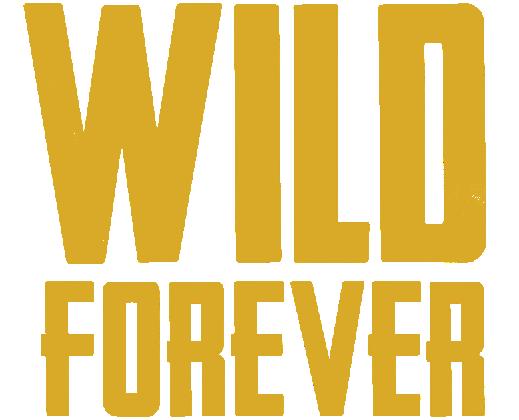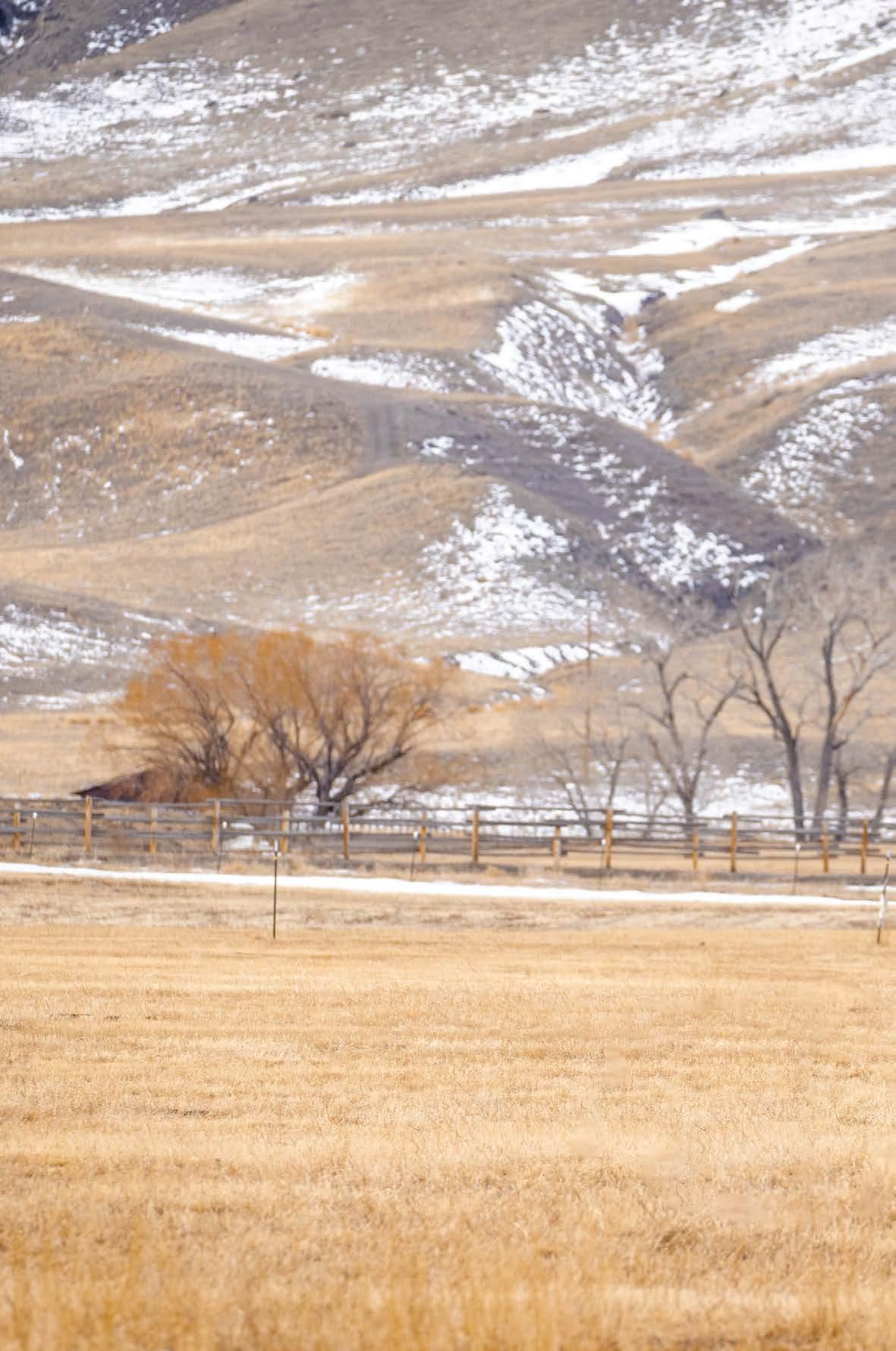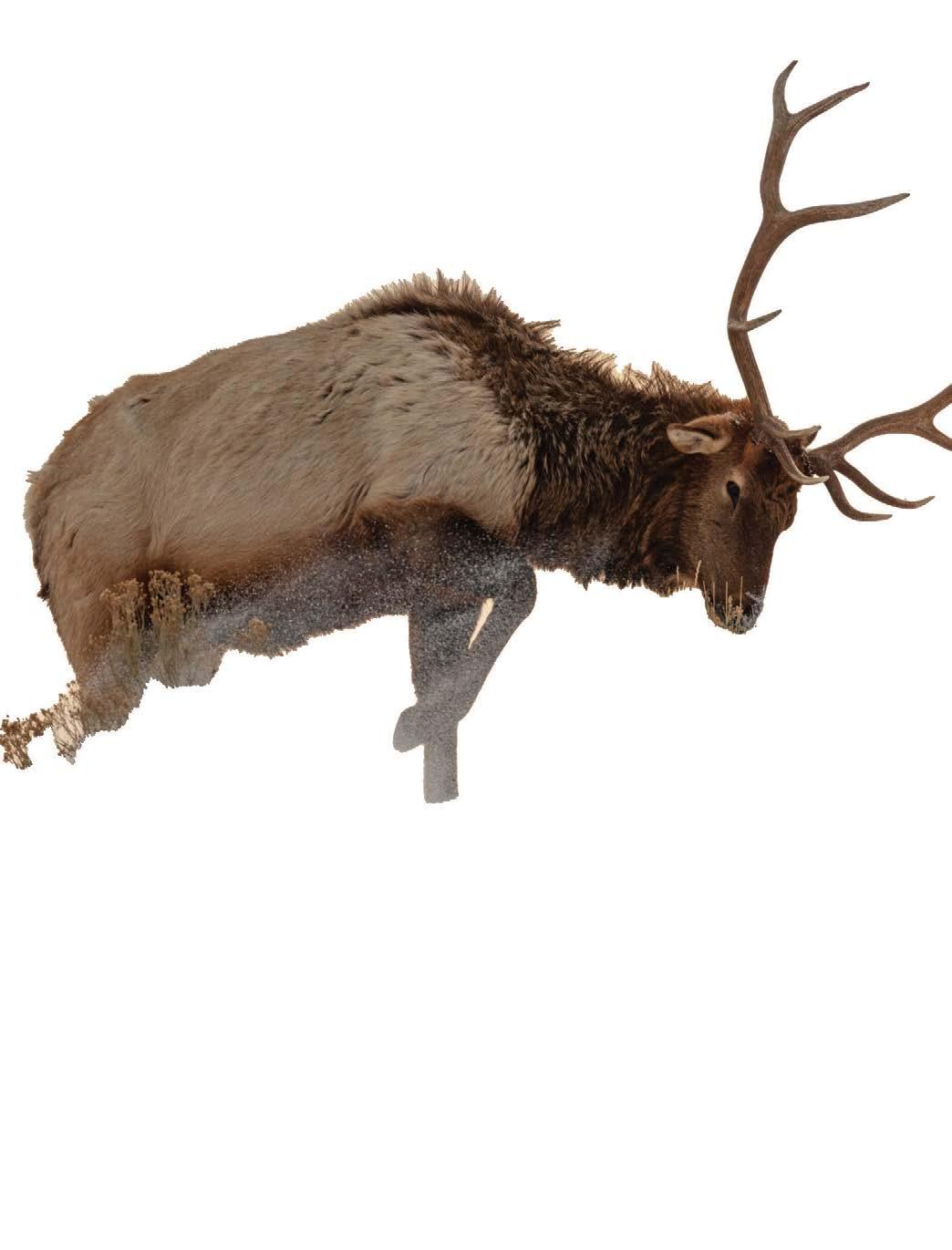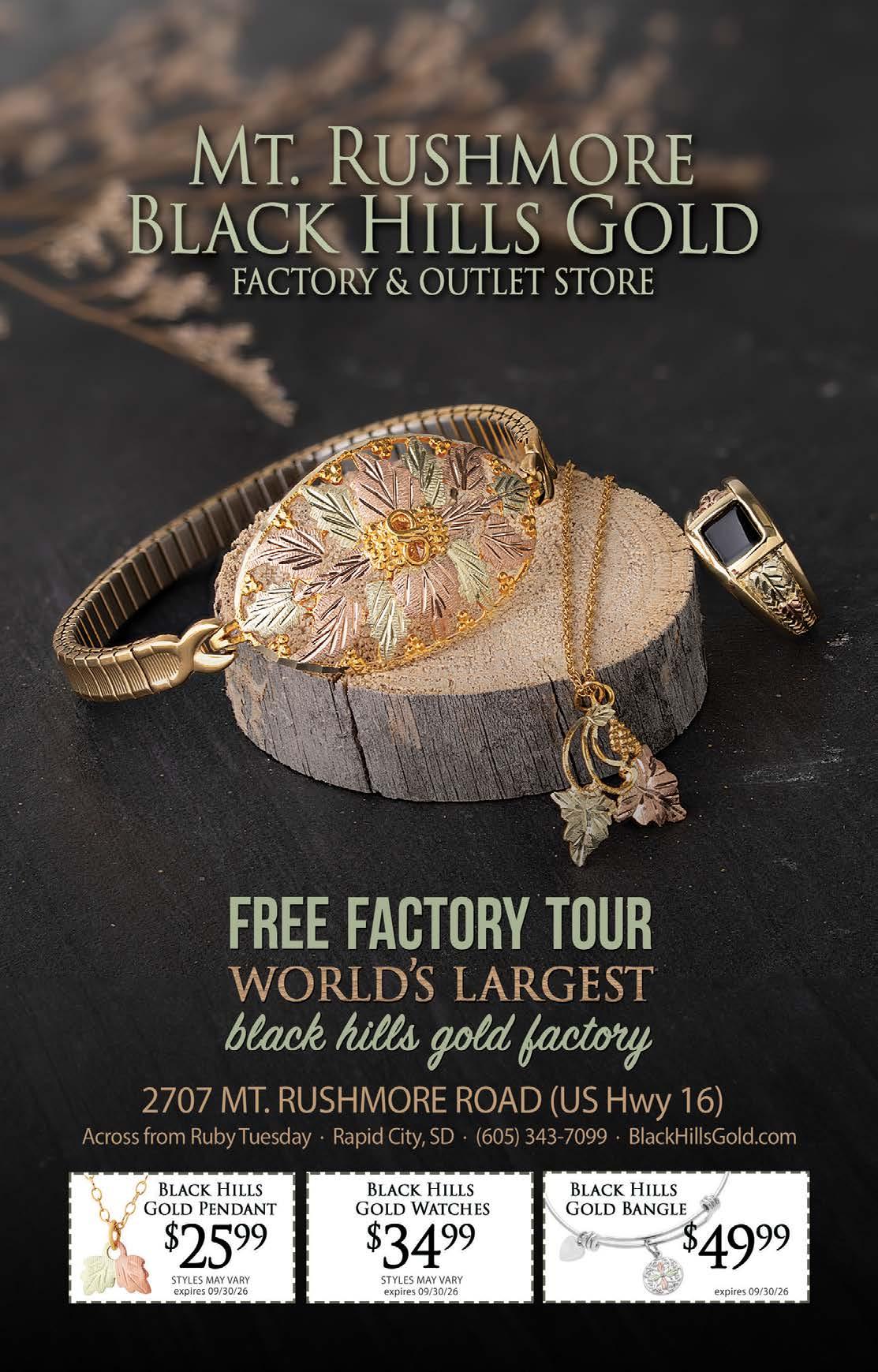BHVISITOR

PEAK
HISTORY LEGENDS WONDER NEW! GO BEYOND THE PAGES WITH INTERACTIVE CONTENT PEAK
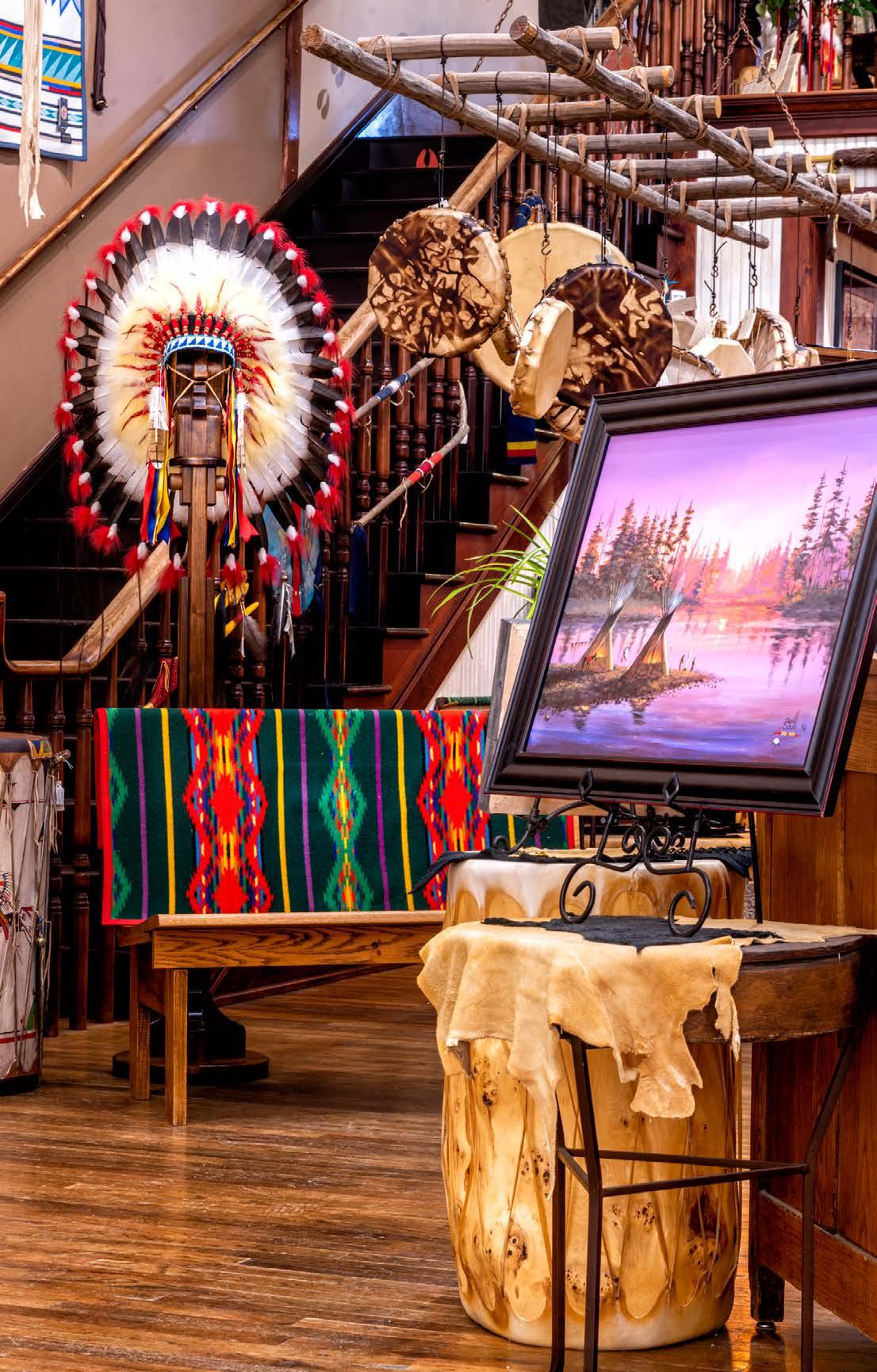


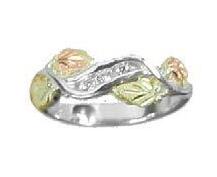

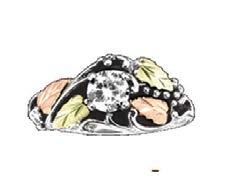

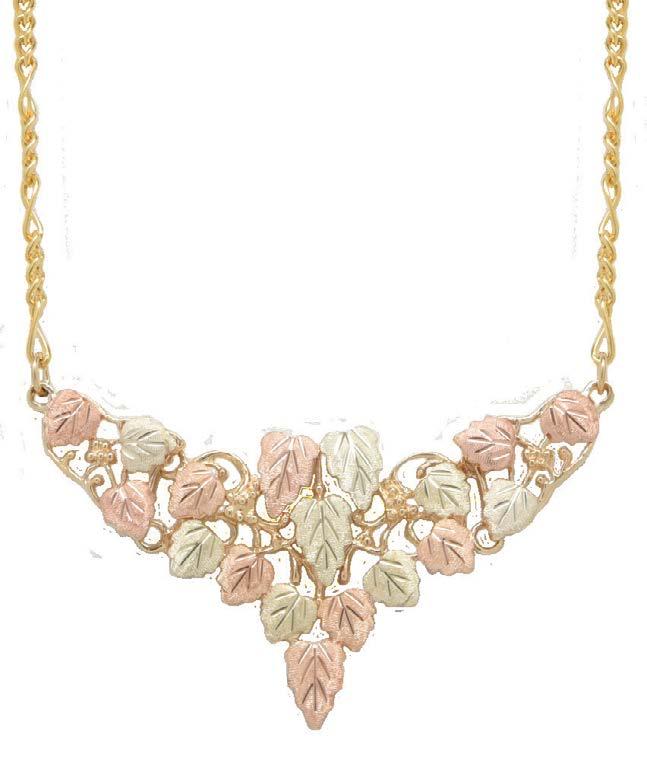
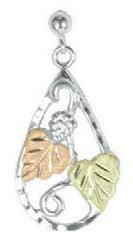



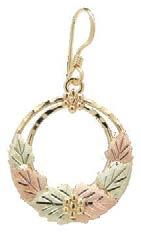

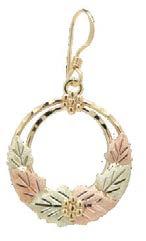













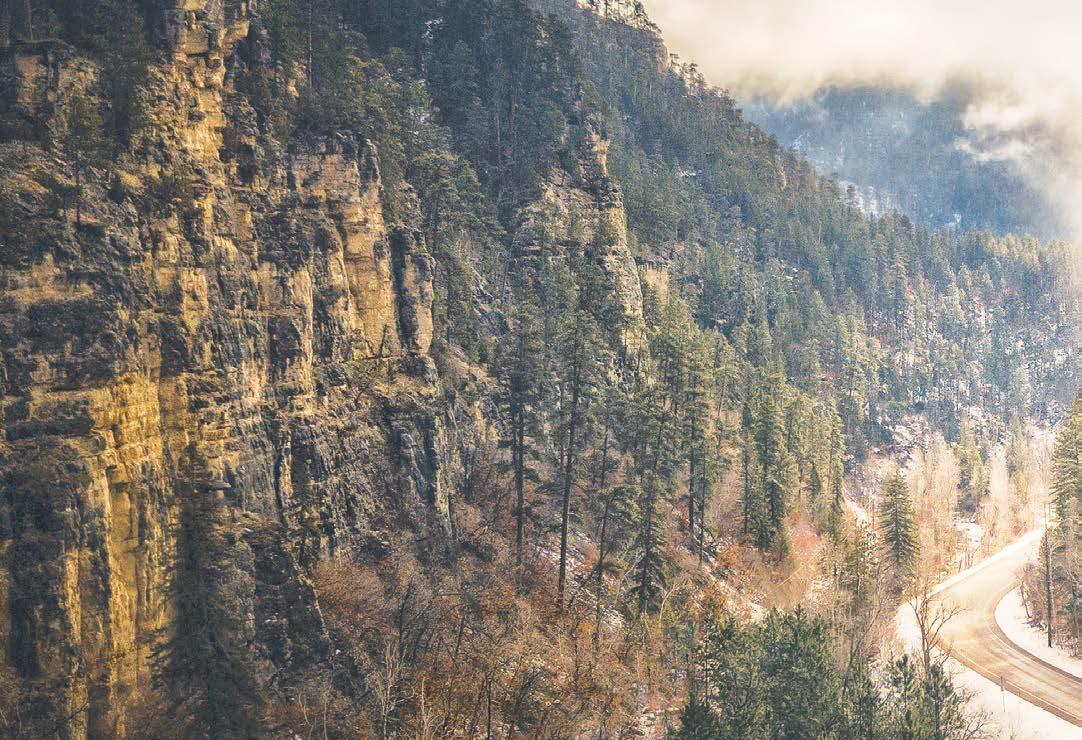


HISTORY LEGENDS WONDER NEW! GO BEYOND THE PAGES WITH INTERACTIVE CONTENT PEAK





























NOVEMBER
7-9 Girlfriends’ Weekend, Hill City
8 Big Whiskey Festival, Deadwood
11 Veterans Day Ceremony, Main Street Square, Rapid City
26 1880 Train Holiday Express Begins, Hill City
28 Christmas Nights of Light Begins, Storybook Island, Rapid City
29 Holiday Celebration & Winter Market, Main Street Square, Rapid City
29 Festival of Lights Parade, Rapid City
DECEMBER
6 Custer Christmas Parade, Custer
JANUARY
17 Burning Beetle, Custer 23-24 Deadwood Snocross Showdown, Deadwood 30-Feb. 7 Black Hills Stock Show & Rodeo, Rapid City
FEBRUARY 13-15 Black Hills Sports Show & Outdoor Expo, Rapid City 13-14 Mardi Gras Weekend, Deadwood
14 Sundance Winter Festival Sundance, WY 20-22 Winterfest, Lead 23-Mar. 1 Restaurant Week, Custer
MARCH
13-14 St. Patrick’s Day Weekend, Deadwood Publisher Rick DenHerder Communications
Stephen Simpson Digital
Rainey
BlackHillsVisitor.com ©Black Hills Visitor. All rights reserved. Reproduction of any part of this publication without the express consent of the publisher is prohibited. The information included in this publication is believed to be accurate at the time of publishing. More articles and advertisers can be found online at BlackHillsVisitor.com.

Welcome to the Black Hills, and thanks for picking up the fall and winter edition of Black Hills Visitor.
If you’ve never been here this time of year, you might think it’s prime time for hunkering down indoors. And sure, there’s magic in sinking into a comfy chair next to a crackling fireplace with a glass of locally-produced wine or beer while snow blankets over the ponderosas — but that’s only half the fun. From golden autumn hikes through fiery foliage to snowshoeing and skiing under sparkling winter skies, there’s always something new to discover and try. Whether it’s a crisp 55 degrees or a frosty 15, the Black Hills are bursting with adventure, ready to surprise you every single month.

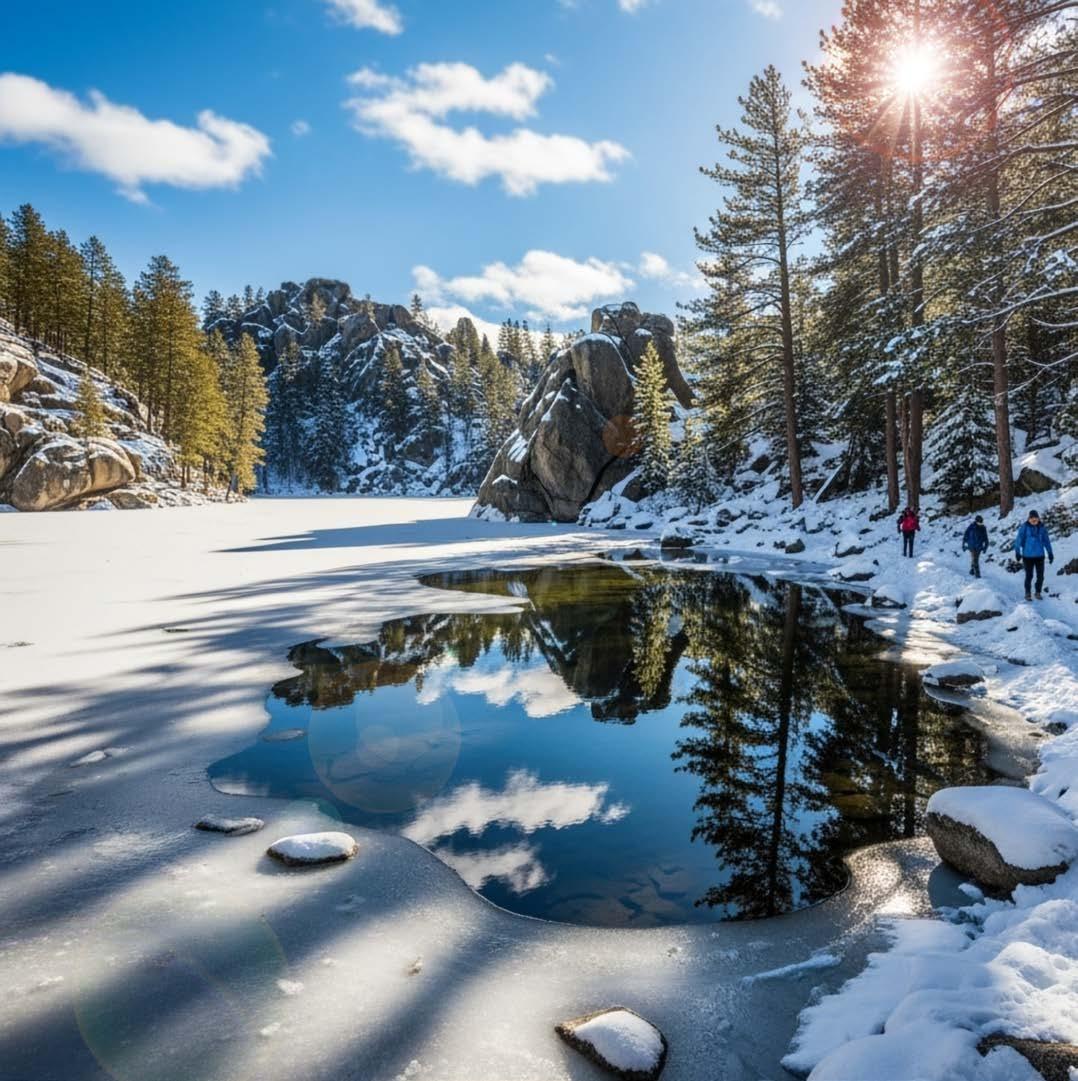
Think the Black Hills are best enjoyed during the warm summer months? Don’t let colder weather keep you indoors; there’s plenty to do this time of year — you might just have to dress in layers!
Swap your boots for snowshoes and discover the Black Hills like never before — quieter trails, sparkling snow, and a winter adventure waiting at every turn. Scan the code above to learn more about snowshoeing in the Black Hills.
HIKING There are more than 450 miles of hiking trails in the Black Hills National Forest. Favorite spots include Black Elk Peak, Cathedral Spires, Little Devils Tower, and the Mickelson Trail. You’ll marvel over
60 miles of trails are available to snowshoers, cross-country skiers, and fat tire bikers throughout the Black Hills National Forest.
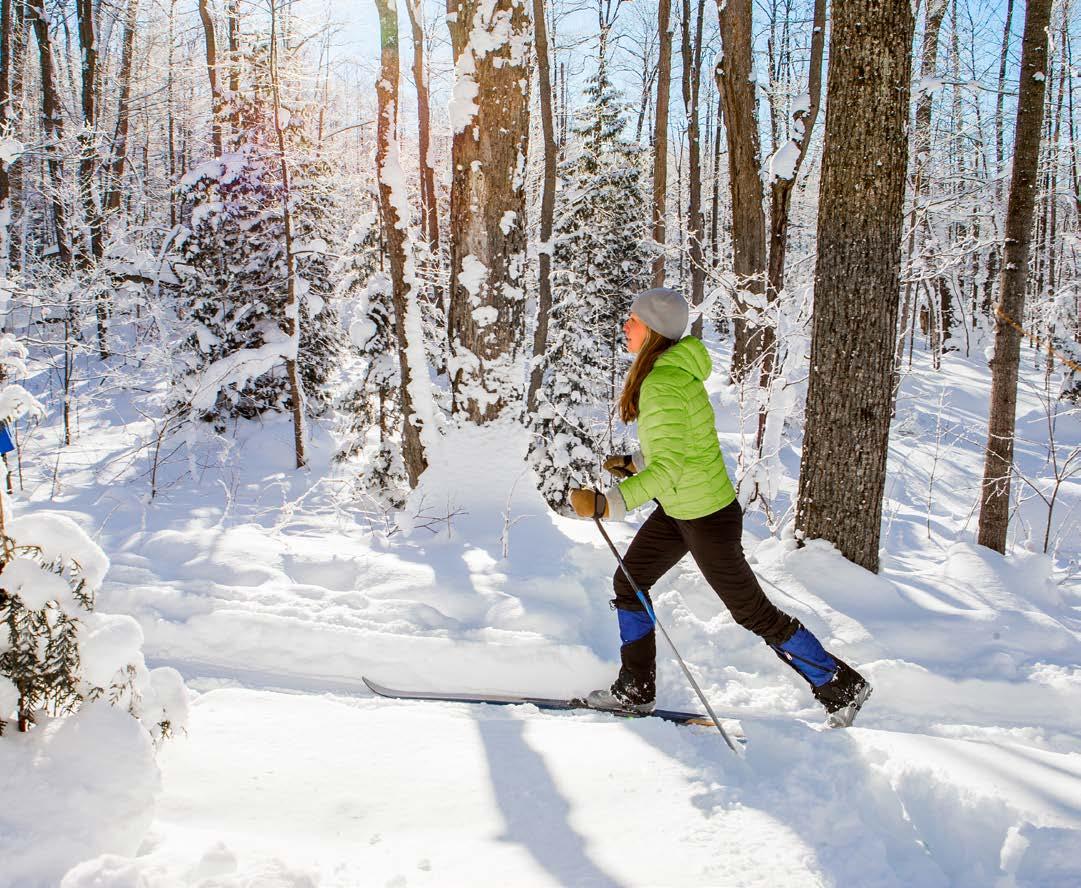
majestic granite peaks and frozen lakes. Beautiful Spearfish Canyon features prime fall foliage viewing. When the leaves are gone, aweinspiring frozen waterfalls and creeks take center stage.
ICE FISHING All lakes within the Black Hills National Forest are open to ice fishing as soon as the ice is safe (typically mid-December). Prime spots include Sheridan Lake, Deerfield Reservoir, and Pactola Reservoir in the Central Hills; Roubaix Lake in the Northern Hills; and Stockade Lake in the Southern Hills. If you’ve never tried it before, look for shallow water where fish are close to the surface, and never take the ice depth for granted
— always test the location before driving onto or drilling into the ice.
SKIING & SNOWSHOEING South Dakota isn’t a well-known skiing destination, making Terry Peak Ski Resort one of the region’s best-kept secrets. With 150 inches of annual
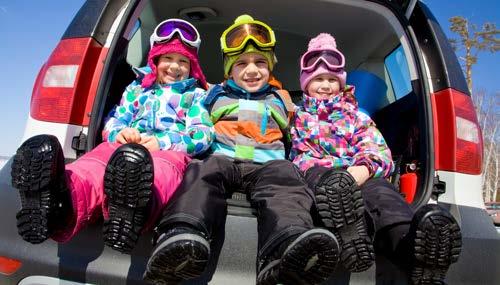
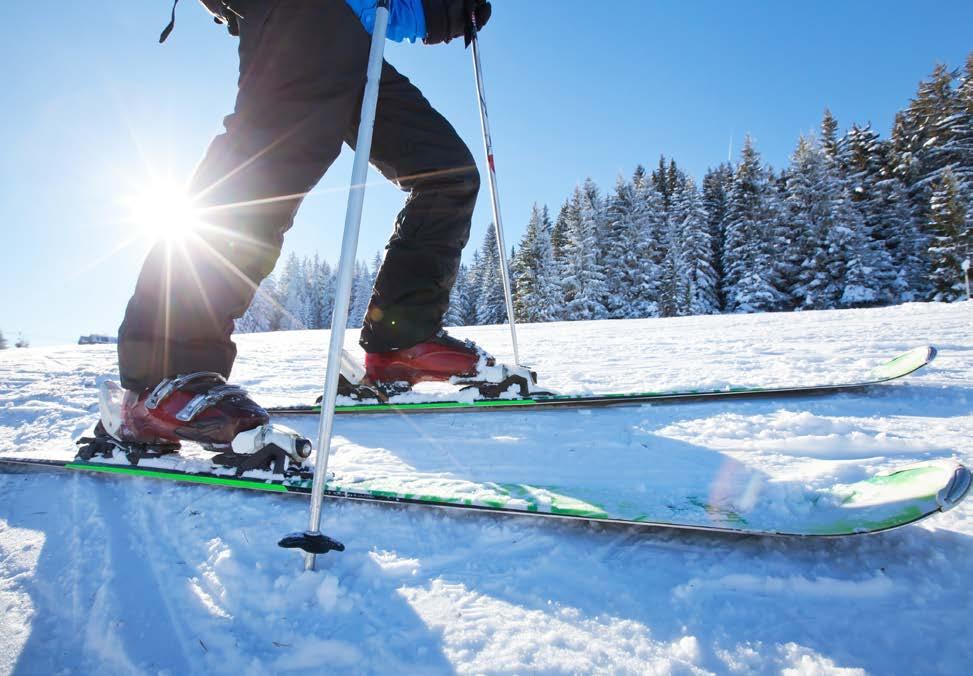
snowfall, freshly-groomed slopes, and the highest vertical drops east of the Rockies, the mountain is a popular winter getaway for locals and visitors.
Ski season usually begins around Thanksgiving weekend and runs through late March or early April. For a more leisurely experience, strap on a pair of snowshoes or crosscountry skis. Sporting goods shops in the area have a large selection of gear for sale. If you’re a novice, consider renting from a ski shop or winter recreation outlet first.
SNOWMOBILING With 350 miles of marked, mapped, and groomed snowmobile trails, the Black Hills
have garnered national attention as a premier snowmobiling destination. The network of trails meanders through ponderosa pine forests, canyons, and open meadows, and includes pit stops for gas and warming shelters. Trails are usually open from December 15 to March 31, but dates might change based on snow conditions.
BIKING The Centennial Trail stretches from Bear Butte State Park to Wind Cave National Park and offers 111 miles of single-track riding options for mountain bikers and fat tire enthusiasts. Trailheads throughout the Hills make great starting or stopping points. Other
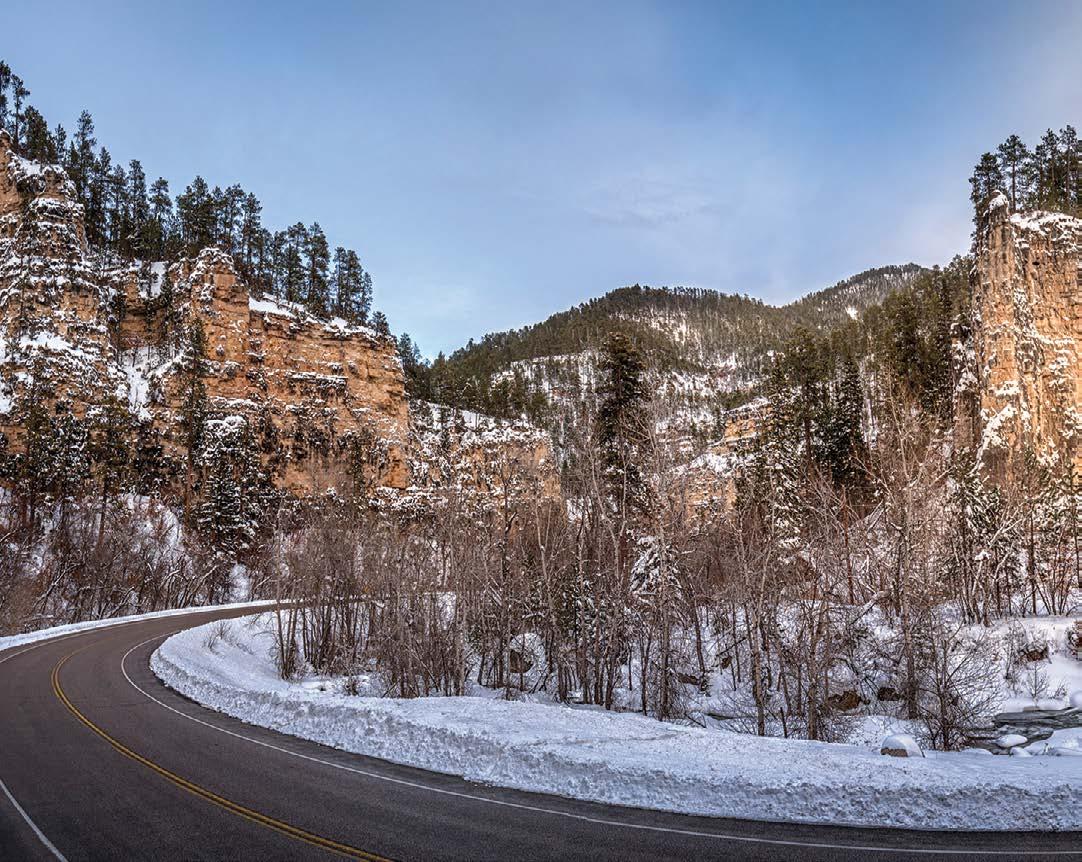
Spearfish Canyon is beautiful yearround, and fall is no exception. Hit the road for a scenic drive and check out the changing leaves. If you stick around for winter, the waterfalls turn into incredible ice sculptures.
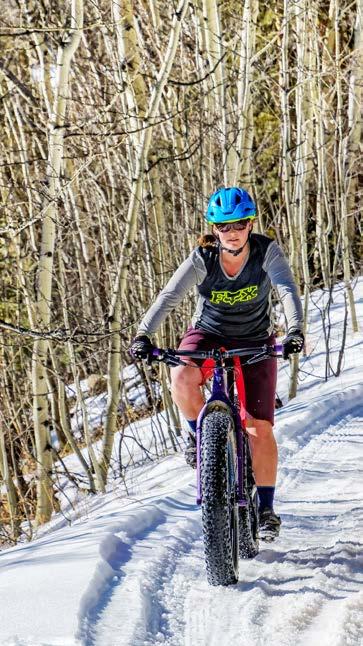
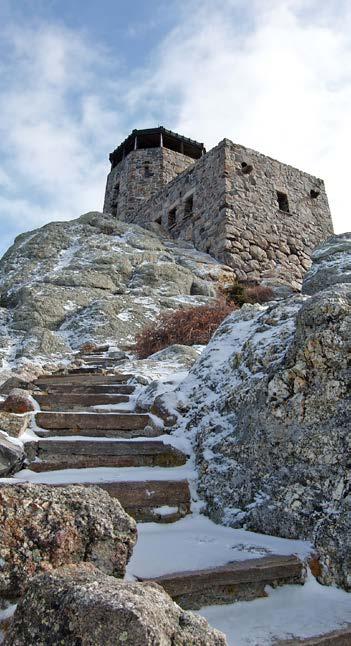
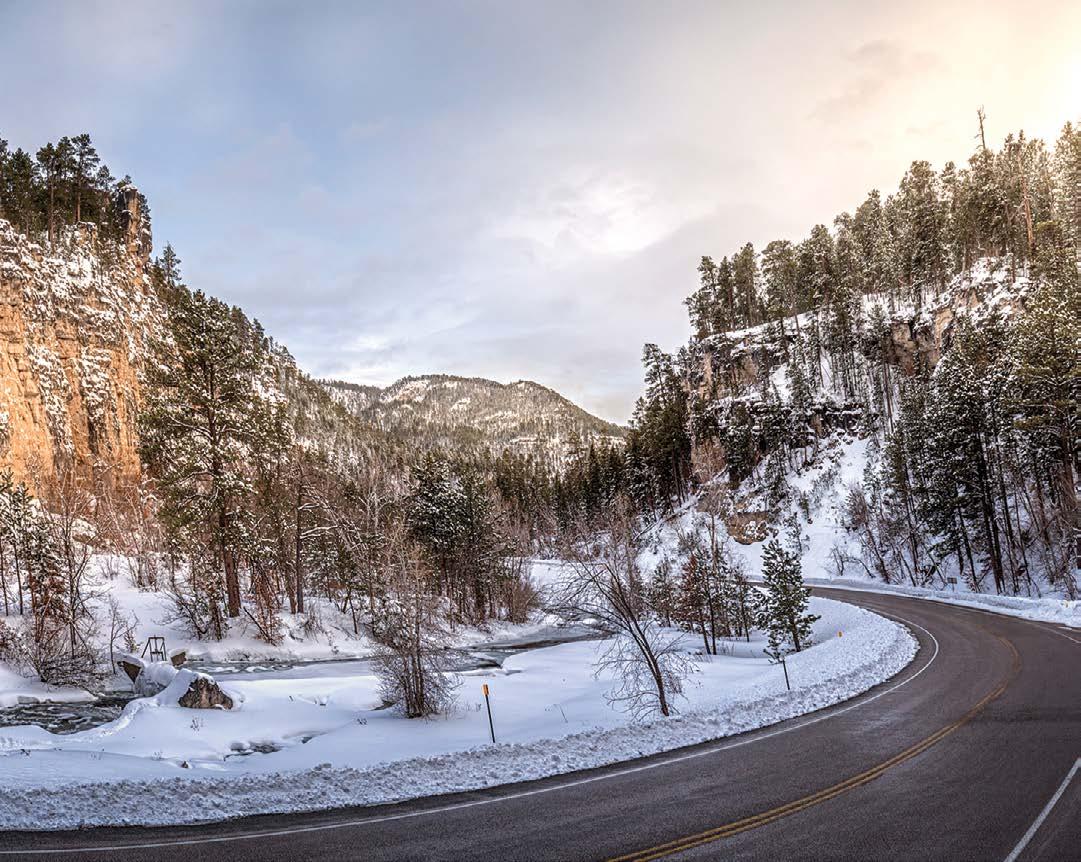
popular biking trails include the Mickelson Trail, Storm Mountain, Buzzards Roost, and the ominously named (but quite rideable) Bone Collector in the town of Hisega.
GEOCACHING For a free adventure that doubles as a good old-fashioned treasure hunt, the Black Hills area offers thousands of hidden caches throughout the region. Some are easy to find, while others require quite a bit of searching. This is a great familyfriendly adventure. All you need to get started is a smartphone. If you’re into the thrill of the hunt, visit geocaching.com for a list of cache coordinates and treasure location information.
SCENIC DRIVES If it’s simply too cold out, the beauty of the Black Hills can be enjoyed from the comfort of your car. Spearfish Canyon is a must-see in the fall, when autumn colors paint the surrounding hillsides vibrant shades of gold and crimson. Take the 22-mile Spearfish Canyon Scenic Byway (Route 14A) and allow yourself plenty of time to pull over and take pictures. Don’t miss out on the canyon’s picturesque waterfalls! The Needles Highway (Hwy. 87), with its world-renowned granite spires, is another fantastic fall drive — be sure to complete it before snow closes it for the season (typically in mid-October). The 70-mile Peter Norbeck Scenic Byway features majestic “pigtail” bridges, granite tunnels, tight curves, and prime wildlife viewing.
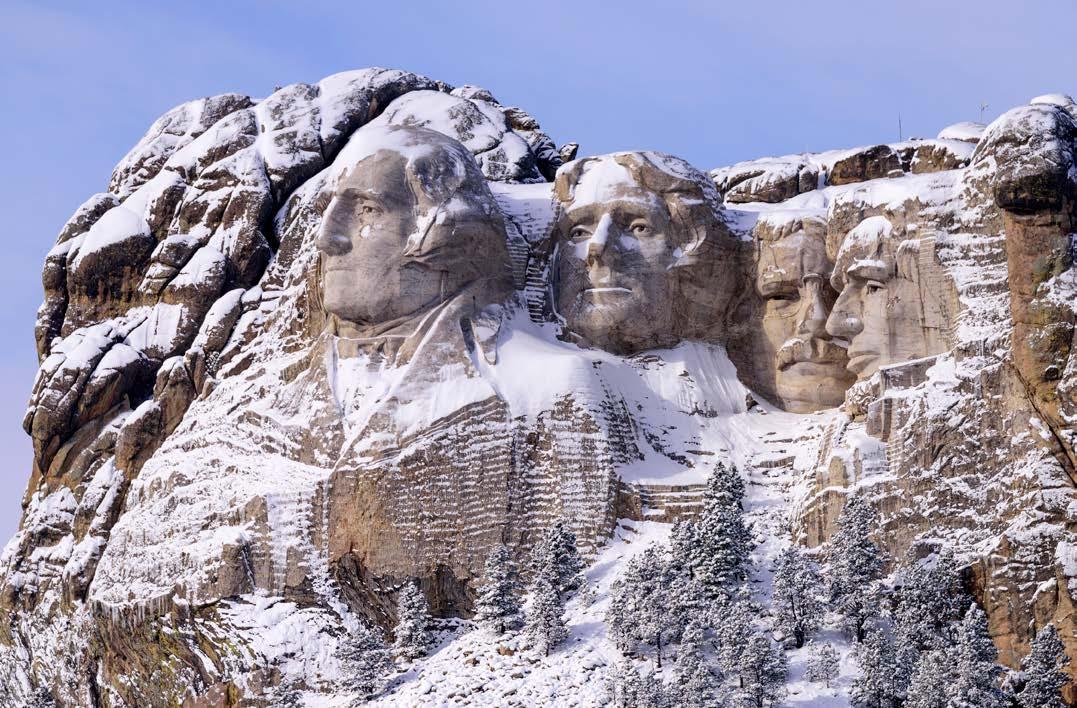
Seeking a way to promote tourism in the Black Hills, South Dakota state historian Doane Robinson came up with the idea of carving likenesses of historical figures into stone. His original suggestion involved sculpting Old West heroes into the granite pillars of the Needles, but the project evolved when sculptor Gutzon Borglum was brought on board. Borglum felt American presidents would be a bigger draw and eventually settled on four who were influential in promoting and
expanding American democracy: George Washington, Thomas Jefferson, Abraham Lincoln, and Theodore Roosevelt. Due to the scope of the project, higher quality rock, and better sun exposure, Borglum felt Mount Rushmore near Keystone would be the ideal location for his monument. President Calvin Coolidge took a break from his summer vacation in the Black Hills to formally dedicate the project on August 10, 1927. Work began two months later and continued for the next fourteen years.
The sculpture is illuminated nightly yearround. During the fall and winter, you can see it lit up between sunset and 9 p.m.
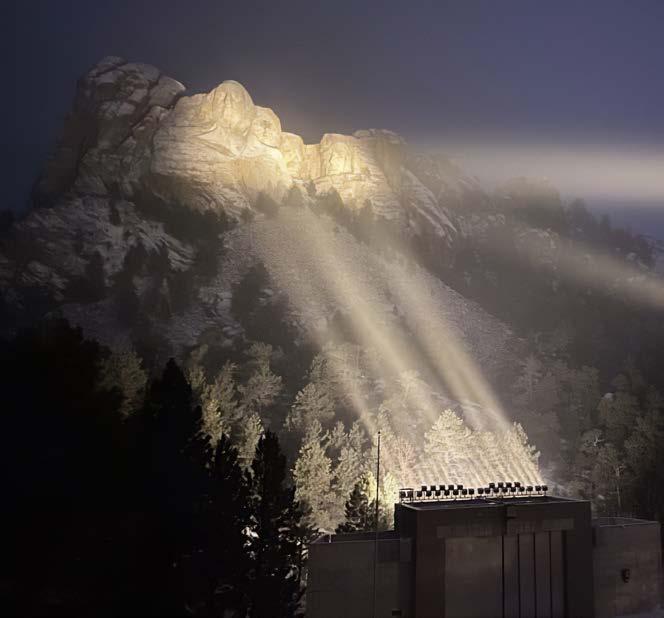
President Calvin Coolidge formally dedicated the carving project of Mount Rushmore on August 10, 1927, and efforts continued on the carving for the next fourteen years.
The visitor facilities at the Monument are open all year, seven days a week, with the exception of December 25, when buildings are closed, but grounds are open.
Even if the temperature outside is cold, you have to to try the ice cream at Carvers Café; it’s based on President Jefferson’s own recipe.
400 workers were hired to remove approximately 450,000 tons of granite from Mount Rushmore using dynamite, a laborious and dangerous task that fortunately resulted in no fatalities. The carvings are 60 feet tall and were originally intended to be even grander in scale. Borglum’s original design had the four presidents carved down to their torsos. A combination of unsuitable rock, lack of funding and the escalation of WWII caused the drilling to stop and for Borglum’s original design to be abbreviated (be sure to visit the Sculptor’s Studio at the memorial to see a model of the original design for yourself).
There is no admission fee charged to see the Memorial, per the wishes of Borglum himself. However, a fee-based system provides convenient parking: $10 per vehicle; seniors pay $5 and free for active duty military.
Evening lighting ceremonies are held beginning the Friday before Memorial Day to Sept. 30 each year. Check with the attraction in advance for updates to the lighting schedule.
contains a hidden chamber filled with porcelain panels that tell the story of the carving.
Even solid granite isn’t immune to time — Mount Rushmore is slowly eroding. Wind, rain, and freeze-thaw cycles chip away at the massive presidential faces, making maintenance a constant challenge. Engineers regularly monitor cracks and take care to preserve Gutzon Borglum’s monumental vision. So when you stand at the base, marveling at Washington, Jefferson, Roosevelt, and Lincoln, remember: Mount Rushmore is a living monument, slowly weathering the elements while inspiring generations to come.
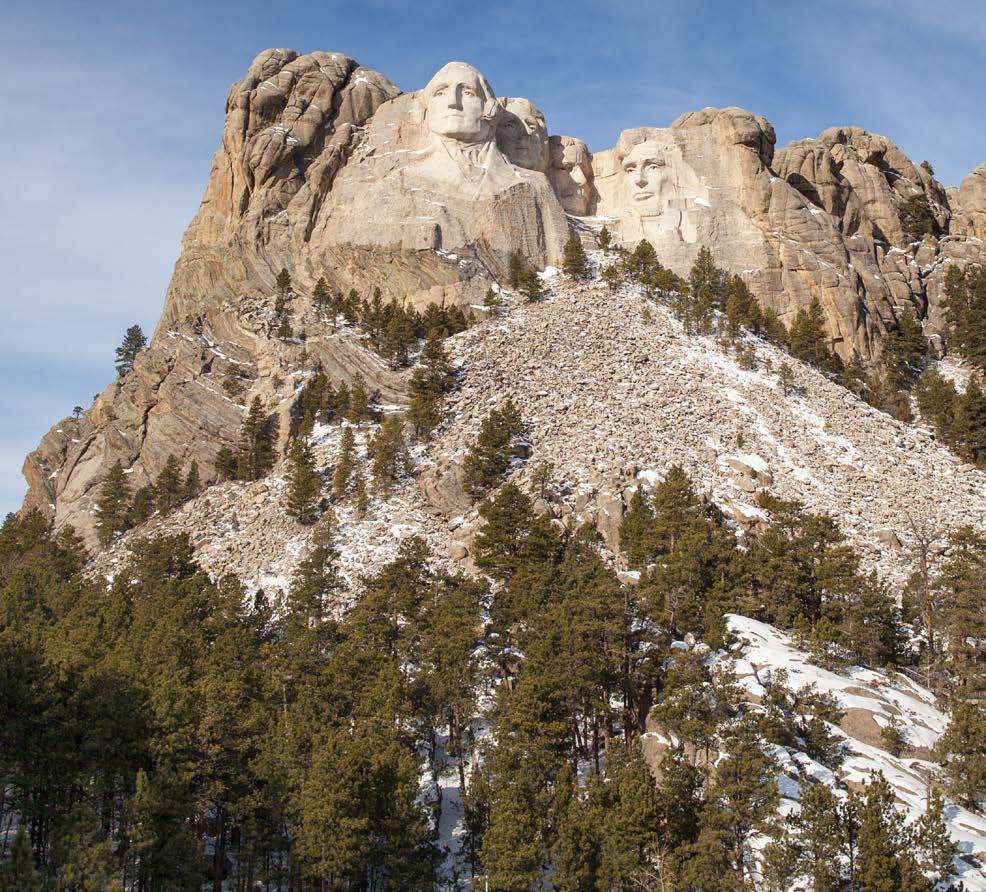
When Borglum died in March 1941, the project was turned over to his son, Lincoln, for completion. It was declared complete on October 31, 1941 and quickly became South Dakota’s most popular tourist attraction. Approximately two million people from all over the world visit the monument annually.
Make sure to take advantage of all this National Memorial has to offer. After parking, make your way up the
stairs and past the Avenue of Flags, a collection of 56 flags of U.S. states, territories, and commonwealths. The amphitheater viewing deck provides awe-inspiring views of the four faces; for a different perspective, walk the Presidential Trail, a half-mile loop at the base of the monument. Be sure to visit the Lincoln Borglum Visitor Center and Museum for interactive exhibits and a short film. You might also take an audio tour, pick up souvenirs at the gift shop, and grab a bite to eat at Carvers Cafe.
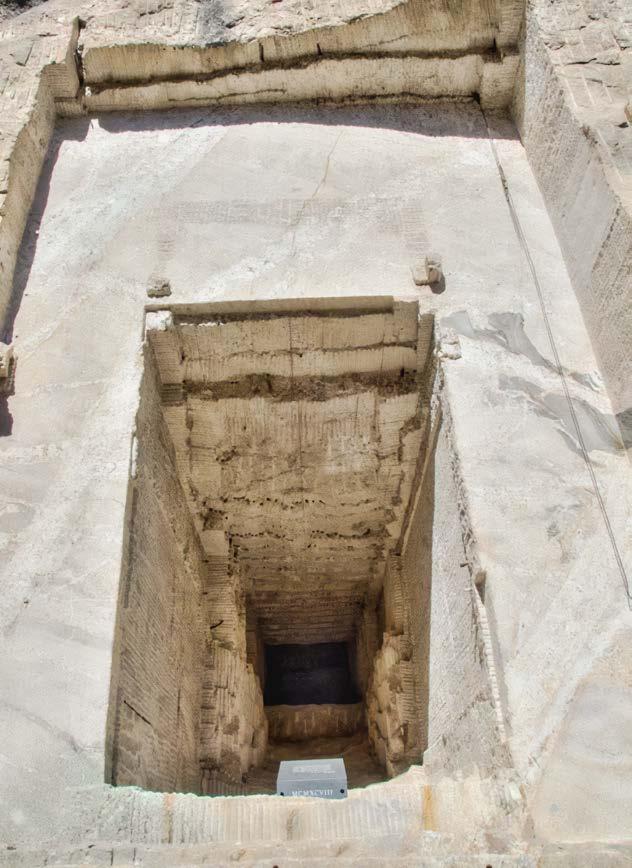
Hidden within the towering granite cliffs of Mount Rushmore lies a mystery that has intrigued many — the Hall of Records. Designed by Gutzon Borglum himself, the Hall was intended to be a hidden chamber behind the monument, where important American documents and artifacts would be stored.
Borglum believed that future generations might find Mount Rushmore as much a mystery as Stonehenge is to modern man, and wanted to come up with a way
Read more about the mysterious Hall of Records at Mount Rushmore National Memorial by scanning here. Uncover the true contents of the mysterious chamber!
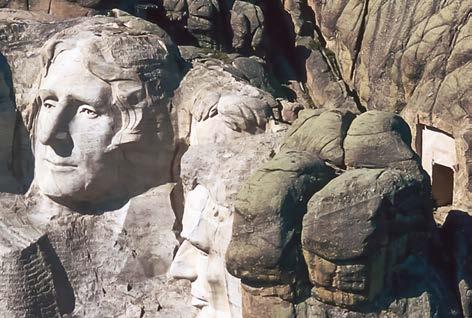
to preserve its history and ensure the story behind the carving would never be forgotten. The project was started, but never completed, and rumors began to circulate about the possibility of hidden treasures within the chamber.
The Hall of Records has become the subject of myth, but the true contents are even more fascinating. Scan the QR code above to discover more.
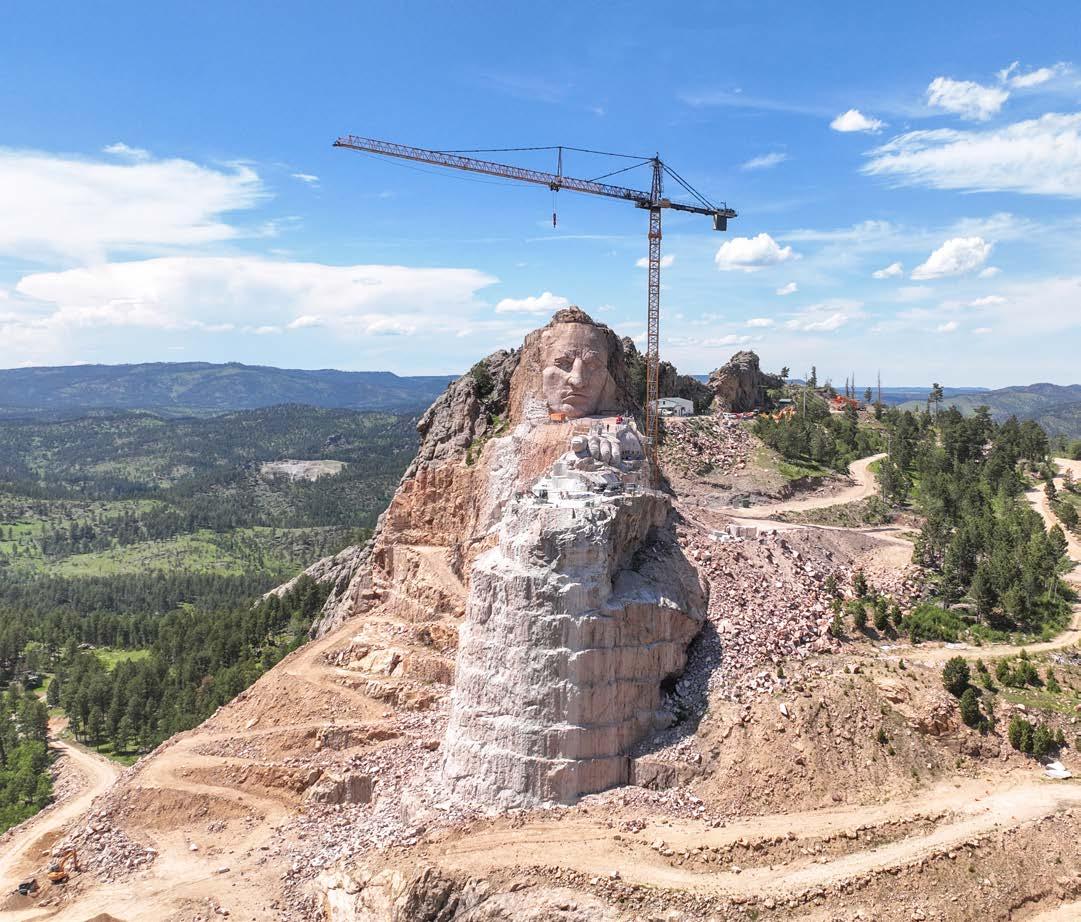
THE PURPOSE
Crazy Horse Memorial® exists to honor all Indigenous people of North America. American Indian history and cultures are shared through museums, cultural programs, and the Mountain Carving in progress.
THE HISTORY
The Crazy Horse Memorial® dream began in 1939 when Lakota Chief Henry Standing Bear asked sculptor Korczak Ziolkowski to create a memorial to pay tribute to American Indians. Standing Bear and others chose Lakota warrior Crazy Horse to be the subject.
In the early years, Korczak, his wife Ruth, and their ten children were responsible for Mountain progress and visitor center operations. In 1982 Korczak passed away, leaving Ruth and the children to continue the work. In 2014 Ruth passed away. Today, the talented management and staff at Crazy Horse Memorial Foundation is led by a diverse Board of Directors, an organizational structure which was established in 1948 by Founders Chief Henry Standing Bear, Korczak Ziolkowski and Ruth Ziolkowski.
Crazy Horse Memorial: 12151 Ave of the Chiefs, Crazy Horse, SD 57730. Open year round. 605-673-4681
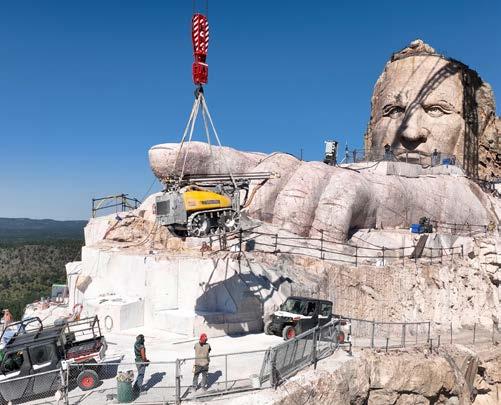
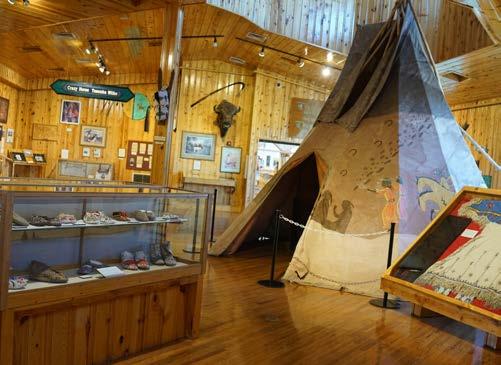
Growth continues in all areas of the Memorial; the Crazy Horse Memorial University ® (formerly The Indian University of North America®), the Museums, the Mountain Carving, and much more.
The Mountain Crew continues detailed finish work on parts of Crazy Horse’s Left Hand and has been removing granite at a steady pace from Crazy Horse’s Arm and the Horse’s Mane. The addition of a tower crane and robotic arm
WHERE
Located north of Custer at 12151 Avenue of the Chiefs. Crazy Horse Memorial® is hard to miss as you drive along Highway 16/385.
The project, founded and operated on a strong belief in free enterprise, is funded by visitor entrance fees and donations and does not accept government funding.
The 40,000-square-foot Welcome Center is where the storytelling begins. Two theaters show the must-see 24-minute video
“What is Crazy Horse.”
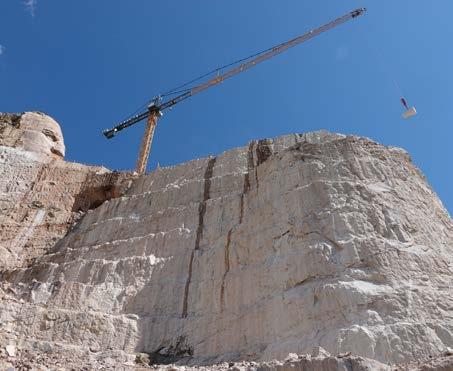
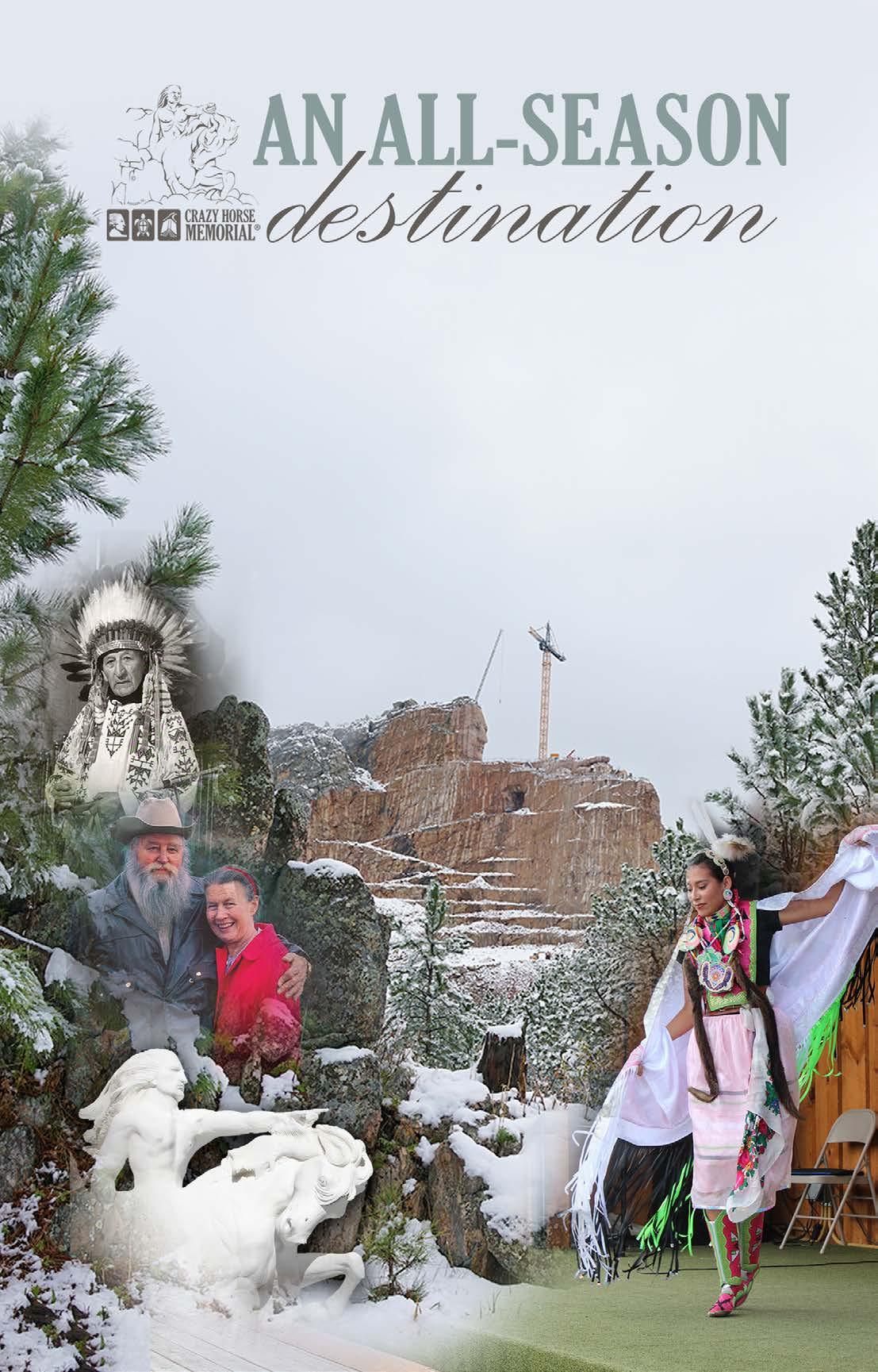
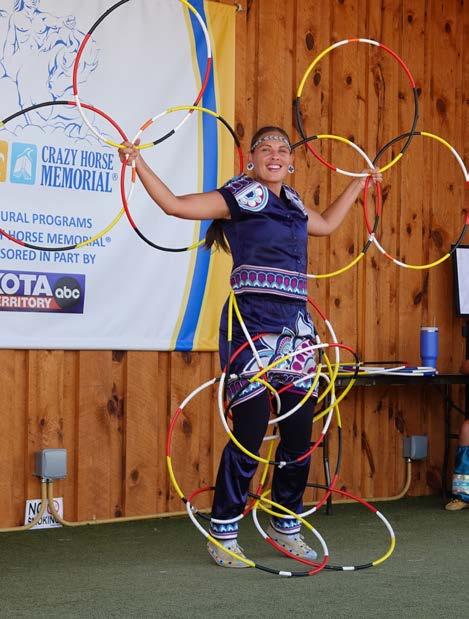
has contributed greatly to progress on the sculpture. The Mountain Carving is the centerpiece yet there is more to experience at the Memorial. The Indian Museum of North America® is home to a large collection of art and artifacts.
The Ziolkowski Family life museum features a view into the original log home and studio of Korczak and Ruth, and their family. The fascinating Mountain Carving gallery is where you get deeper understanding of the Mountain Carving work. During the summer season, visitors are also able to partake in cultural programming; performances, speakers, handson activities, and more. Visit CrazyHorseMemorial.org to plan your return trip during the summer. And that’s just the beginning. Every visit to Crazy Horse Memorial® reveals new layers of history, culture, and inspiration.

explore
Crazy Horse Memorial® shop
American Indian-made and Crazy Horse gifts eat breakfast*| lunch (* off season, on weekends) meet
A perfect, spacious, location to meet a friend for lunch or host a gathering!
Open year-round!
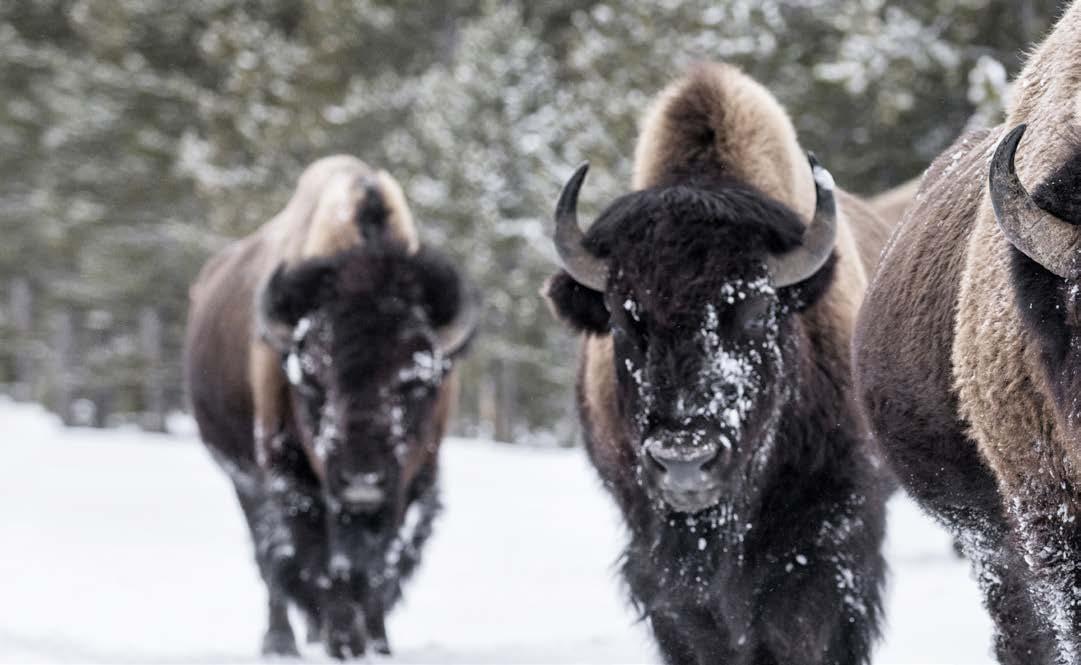
Custer State Park is a 71,000-acre vacation paradise located in the southern Black Hills. It’s open 24 hours a day, 365 days a year, and is renowned for its scenic drives and abundant wildlife.
AS THE SEASONS CHANGE from autumn to winter and snow starts falling, the park’s magnificent wildlife becomes easier to spot. Bison are the most famous inhabitants of the park; nearly 1,400 of them wander the expansive grounds. For an up close and personal experience,
consider taking a Jeep tour. They operate all year and can be requested even in the dead of winter.
HIKING ENTHUSIASTS can take advantage of hiking trails that are open all year. Start the year with guided hikes on January 1, then take on a guided hike of the Lover’s Leap Trail in February.
ANGLERS CAN ALSO enjoy this one-of-a-kind place in the winter.
Custer State Park: 13329 US Hwy 16A, Custer, SD 57730. 605-255-4515
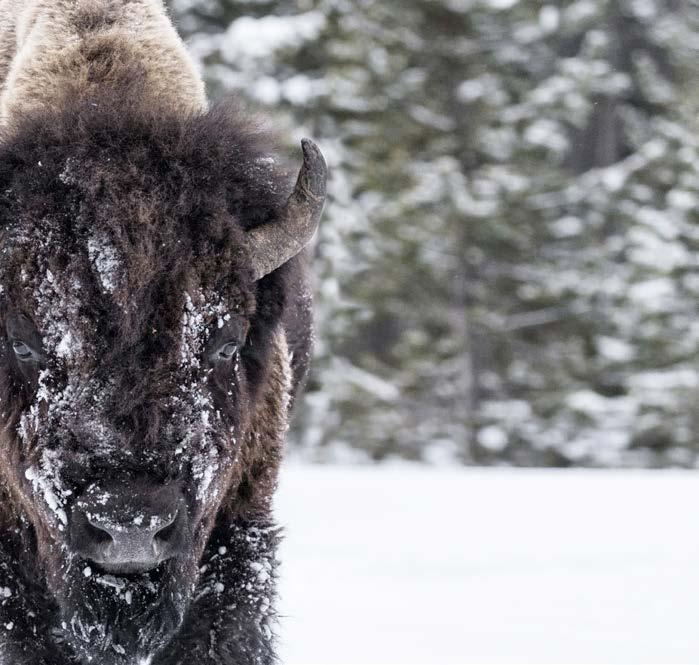
After securing the appropriate fishing permit, visitors can try their hand at ice fishing on one of the many bodies of water at Custer State Park. Just make sure that your chosen lake is frozen to a safe thickness before you step foot on the ice.
YOU MIGHT ALSO WANT TO CONSIDER TRYING SNOWSHOEING for the first time. After you get the hang of it, traversing the landscape over deep snow is a breeze in snowshoes, and you’ll get to experience the landscape in a way that most people miss out on.
WINTER AT CUSTER STATE PARK IS A PHOTOGRAPHER’S DREAM. Frosted trees, snow-dusted granite spires, and icy reflections on the park’s lakes create a serene, otherworldly landscape.
Scan the QR code to explore the top 5 most breathtaking hikes in Custer State Park. From the towering Cathedral Spires to the serene Prairie Trail, each hike offers unique views of the Black Hills’ diverse landscapes.
Whether you’re seeking adventure or a peaceful escape, these trails are a must-see. Lace up your boots (or snowshoes), and start your next adventure today.
Wildlife remains active, giving keen observers the chance to capture bison, pronghorns, and deer against stark winter backdrops. Sunrise and sunset cast soft, golden light across rolling hills, perfect for dramatic shots or quiet nature scenes. Even simple drives along the wildlife loop reveal photo opportunities at every turn. For those who love capturing the beauty of winter in the Black Hills, Custer State Park provides endless inspiration and unforgettable vistas.
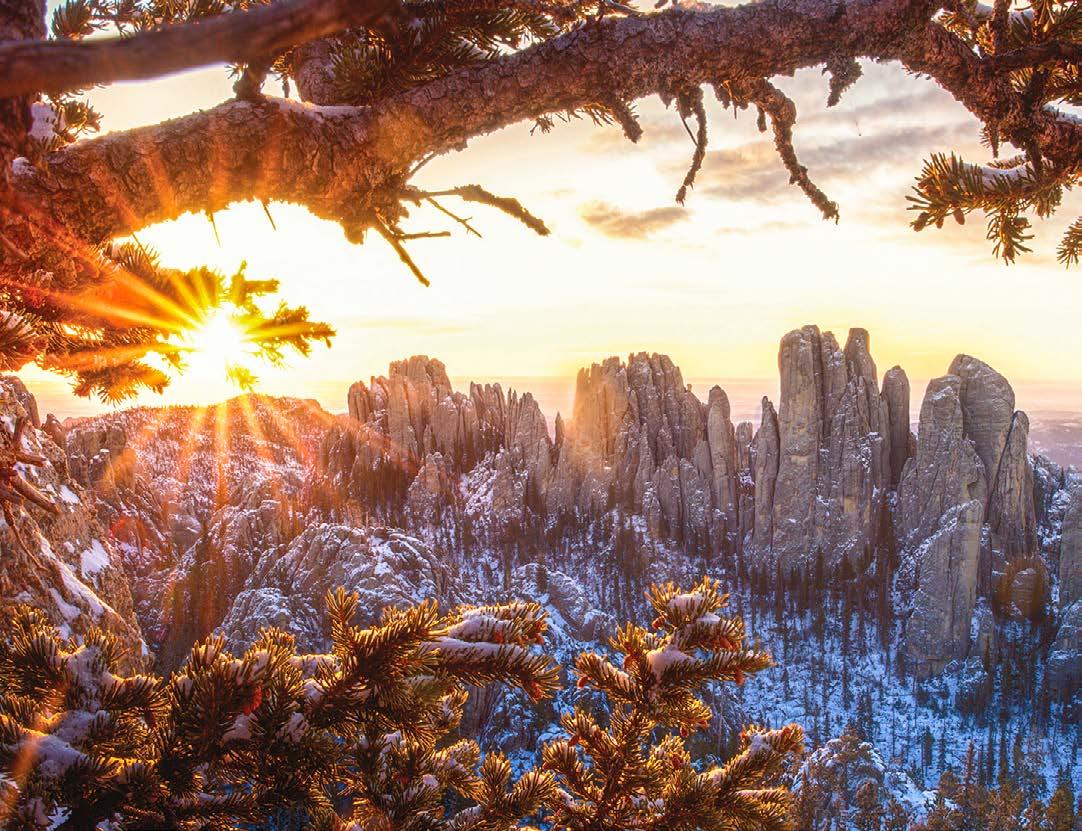
Custer State Park is a model of conservancy and land use, a vision shaped by park founder and former South Dakota Governor and U.S. Senator Peter Norbeck. The park successfully reintroduced a diverse group of species, including bison, elk, Rocky Mountain bighorn sheep, and mountain goats, into the preserve. Remember, all these creatures are wild and should never be approached; view them from a safe distance.
THE CUSTER STATE PARK VISITOR CENTER is a must-see. The beautiful building houses an array of features including educational displays, interactive maps, and a 20-foot tall scale model replica of the Cathedral Spires. You can even find out where the bison are currently located in the park at any given time. A 100-seat theater showcases a 20-minute film, narrated by Kevin Costner. The Visitor Center is open daily from 9 a.m. to 4 p.m. from October 1 to Memorial Day, but closed for Thanksgiving and Christmas Day.
Whether you are an outdoor enthusiast eager to explore the miles of trails or simply driving through the park for the views, Custer State Park has something special for every Black Hills adventurer and visitor.
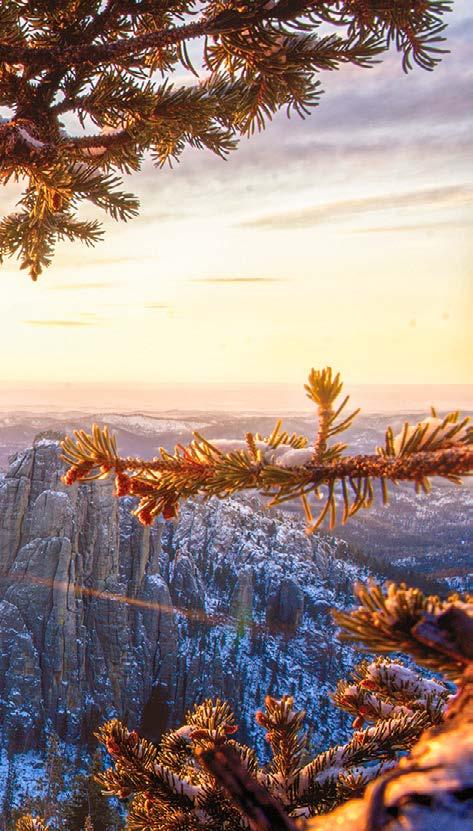
AND DON'T MISS THE BISON CENTER , located in the Wildlife Loop. Take a short detour and discover this state of the art facility located near the buffalo corrals. This family-friendly experience chronicles the history of Custer State Park’s bison herd. Starting with prehistory and covering the beast’s re-introduction and modern herd management practices, the Bison Center leaves visitors with a sense of wonder for the Park’s most iconic creature.
Little travelers can guide a bison’s meal through a model of its four stomachs or push buttons to hear the sound of a mother bison bellowing for her baby.
Enjoy the Bison Center using the same hours and opening schedule as the Visitor Center.
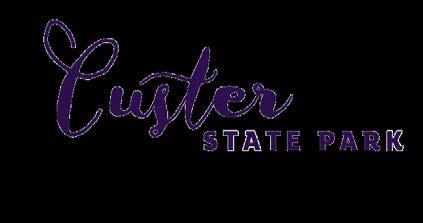
“... a place where one can still be an unworried and unregimented individual and wear any old clothes and sit back on a log and get their sanity back again”
~Badger
Clark~

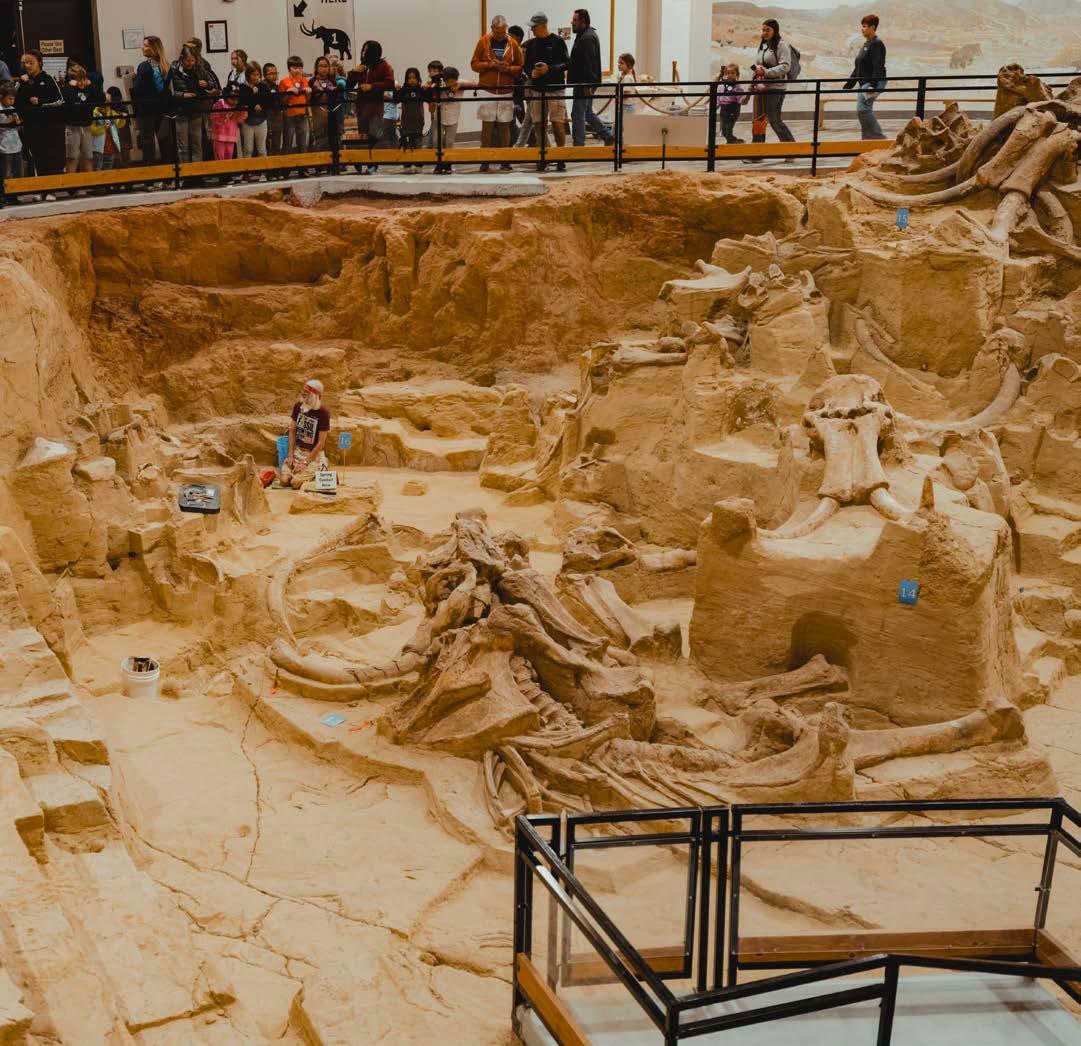
THE STORY BEGAN MORE THAN 140,000 YEARS AGO, when Ice Age fauna were trapped and died in a spring-fed pond near the edge of Hot Springs. Over the course of the next 50,000 years, the sinkhole filled with sediments and mammoth remains.
DISCOVERED BY CHANCE IN 1974, while excavating for a housing development, earthmoving equipment exposed one of South Dakota’s greatest treasures. The Site was found to contain the largest concentration of Columbian mammoths in the world and over 87 other species.

THE MAMMOTH SITE WAS PRESERVED as a resource for scientific study in 1980 and added to the list of National Natural Landmarks. Through the work of local citizens, these 9.8 acres are recognized as an outstanding geological resource.
TODAY THE LOCATION IS NOT ONLY AN ATTRACTION; it is an indoor working paleontological dig site, an Accredited Museum, and a laboratory and research facility where Ice Age fossils are preserved. Visitors can witness scientific work in real time, and who knows? A major breakthrough might even happen while you’re there.

ENCLOSED AND PROTECTED BY A CLIMATECONTROLLED BUILDING, the sinkhole and exhibits attract visitors year-round. Many of the fossils are displayed in-situ, meaning as they were discovered. As the only late Ice Age facility of its kind in North America, The Mammoth Site is a valuable research facility and educational resource that must be preserved for future generations.
The Mammoth Site has also uncovered fossils of ancient bison, camels, horses, saber-toothed cats, and short-faced bears.
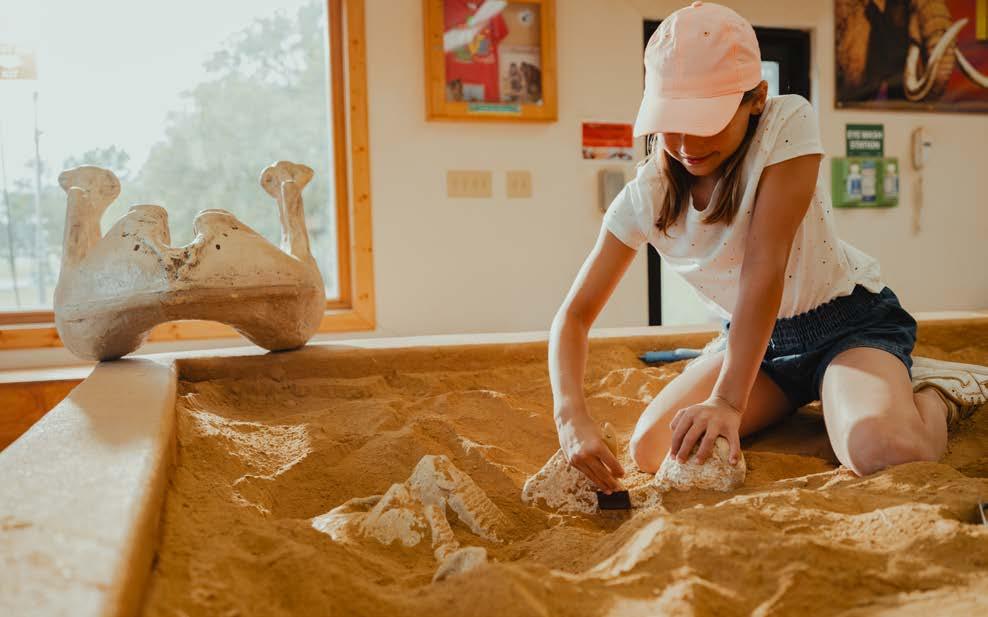
And make sure to get some hands-on experience while visiting The Mammoth Site. In addition to its role as a paleontological dig site and museum, it offers a range of educational programs aimed at engaging the public in the science of paleontology. These programs include the Jr. Paleontology program for children ages 4-12, as well as the Family Dig and Family Ice Age Hunt programs, both geared towards families. Contact The Mammoth Site to confirm availability of these programs during the summer season. The Site also collaborates with educational institutions and research organizations.
Through partnerships, it provides opportunities for students and researchers to engage in fieldwork and study, contributing to the broader understanding of Ice Age ecosystems. These collaborations all contribute to the Site’s overall mission.
The Mammoth Site offers a unique glimpse into the past. Its ongoing research and educational initiatives ensure that this extraordinary site continues to inspire and educate visitors, researchers, and students alike. By preserving and studying these ancient remains, The Mammoth Site plays a crucial role in understanding the history of life on Earth.
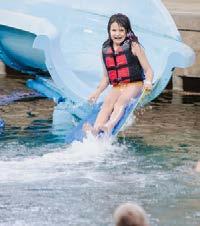
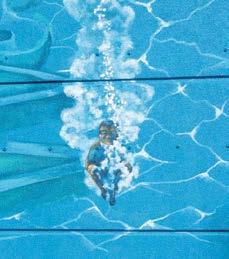

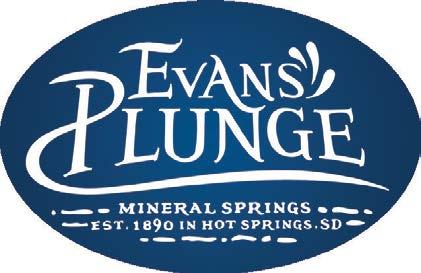

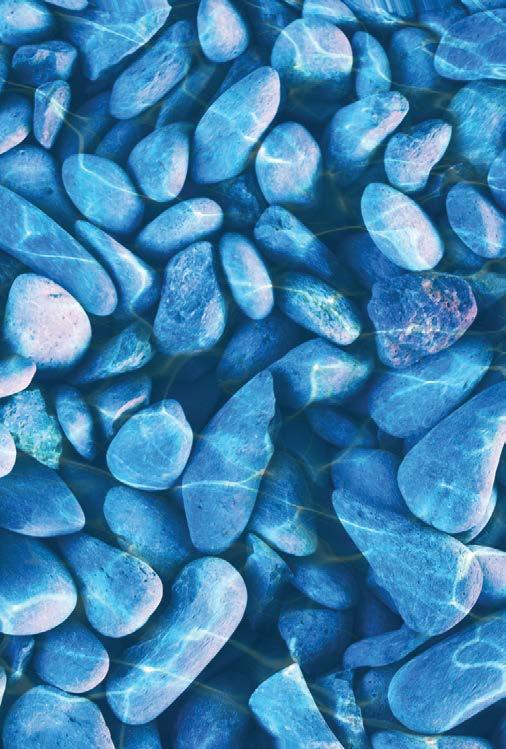



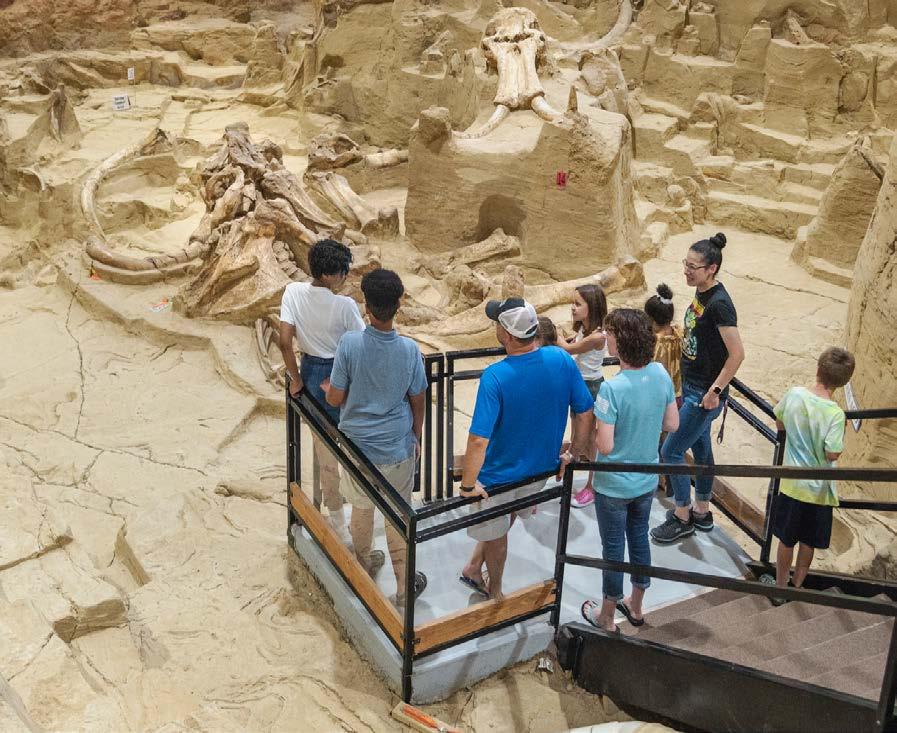
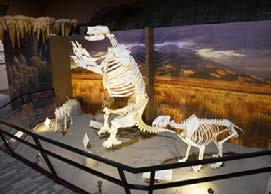
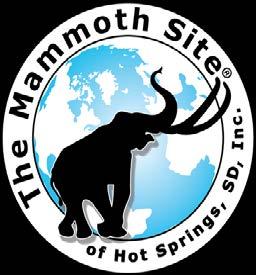
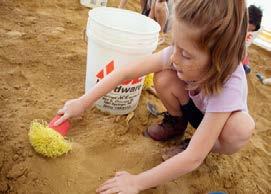
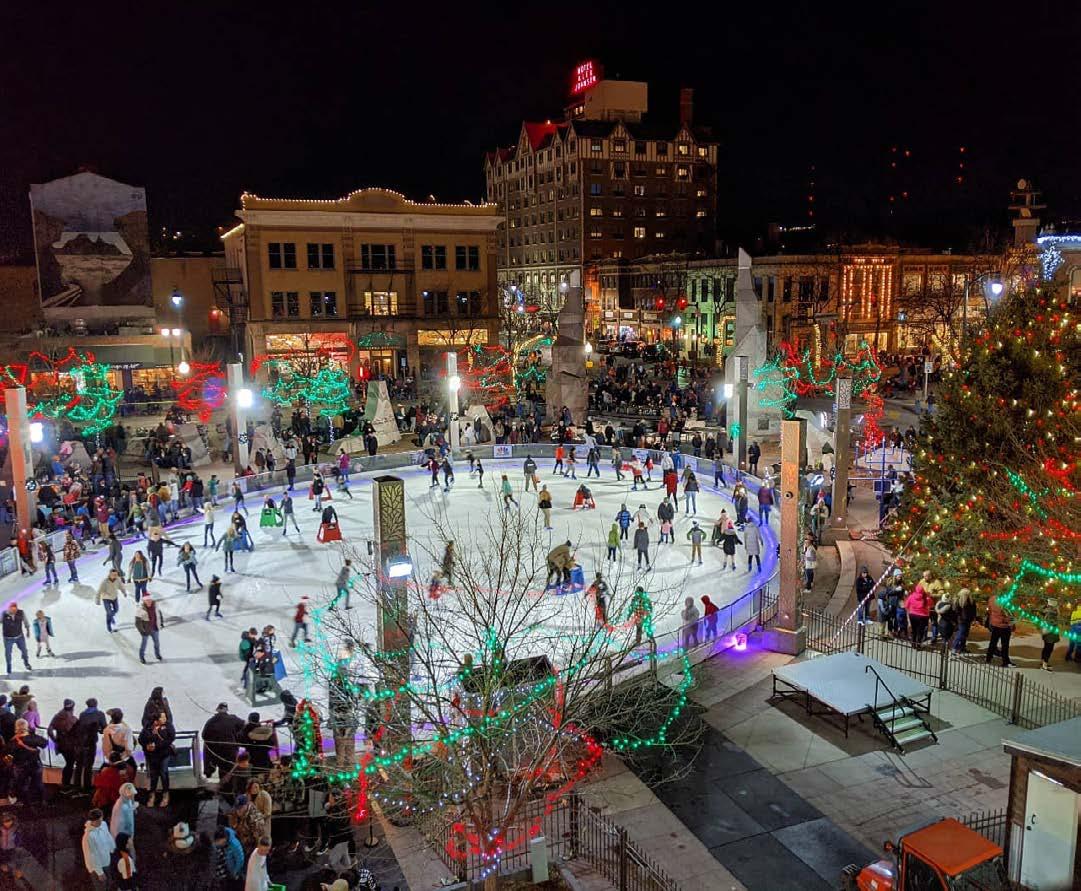
Rapid City was founded in 1876 by a group of down-ontheir-luck prospectors who saw potential in its central location midway between the Hills and prairie. They named their community Hay Camp and sold supplies to the miners and settlers flocking to the region. It was later renamed Rapid City and billed as the “Gateway to the Black Hills.”
Rapid City is the second-largest city in South Dakota and a hub for transportation, commerce, education, health care, and tourism. It offers a variety of shops, boutiques, parks, galleries, restaurants, and family-friendly activities perfect for all ages.
Rapid City’s downtown is a perfect blend of historic and quaint. Its bustling streets are lined with a cozy collection of buildings restored to their original architectural grandeur. The Hotel Alex Johnson has dominated the city skyline since opening its doors in 1928, welcoming an eclectic group of visitors over the years, including presidents and celebrities. Don’t overlook the unique shops and galleries that also call downtown home; you’ll find a diverse collection of keepsakes including Native American artwork and local craft goods.
Main Street Square: 512 Main St., Ste. 980, Rapid City, SD 57701. 605-716-7979
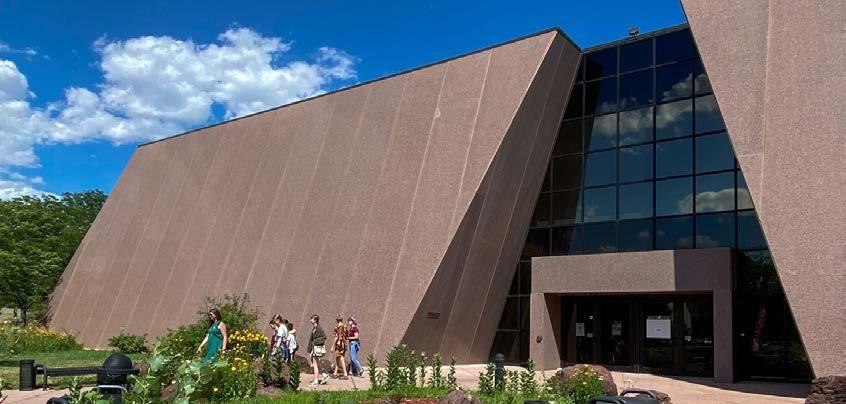
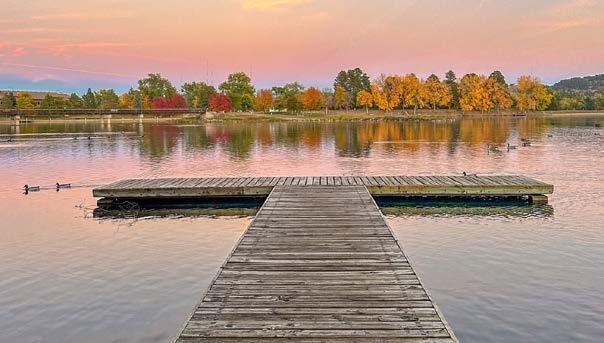
Despite its location in the Midwest, residents of Rapid City are actually accustomed to mild winters. Temperatures will obviously dip in the winter months, but sunshine and 50 degree days in the heart of winter are not uncommon. It’s all thanks to the Banana Belt. The unique geographic features surrounding Rapid City all work together to produce a typically milder winter than other nearby communities.
While you’re here, don’t miss Art Alley, located between 6th and 7th Streets, for a colorful expression of the area’s urban artists.
Main Street Square is a funfilled public space in the heart of downtown. It’s host to a variety of free activities, including special events, art exhibitions, fairs, and open-air concerts. During the winter, the square is transformed into an ice-skating rink. Strap on a pair of skates and make some memories. During the holidays, the square really comes alive and looks like a scene straight
Art Alley is located between these two downtown streets. This organic, community gallery started in 2003.
The most advanced bomber ever built. Ellsworth AFB, just a few miles away from Rapid City, will be its first main operating base.
Valentine McGillycuddy was mayor from 18961898. Read about him and some other wild tales from Rapid City’s early days here.
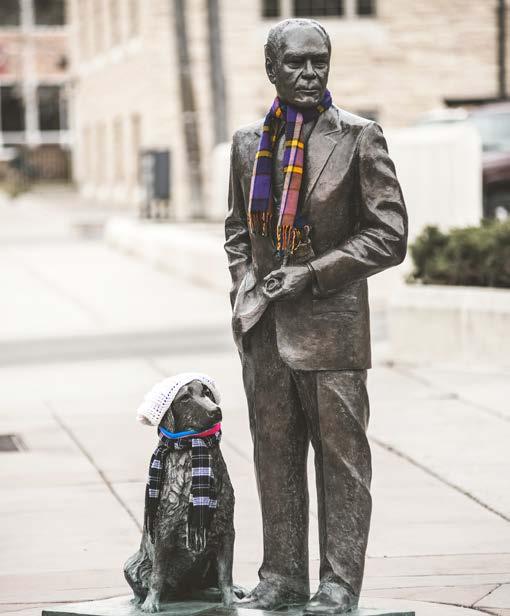
out of a Christmas card with its impressive lights and decorations.
Standing sentinel over town is Dinosaur Park, which features seven life-size concrete dinosaur replicas and spectacular views that stretch 100 miles. The park is free and has been delighting locals and visitors alike since 1936. A major renovation project was recently completed, making the park more accessible than ever.
Rapid City’s patriotic spirit is on full display with the City of Presidents life-size bronze statues located along the downtown corridor’s street corners. Pick up a map for a walking tour, and be sure to pose for photos with your favorite presidents.
43
life-size bronze statues of our nation’s presidents line the city’s streets and sidewalks. The project began in 2000 as a way to celebrate the legacy of America’s presidents and is a popular photo stop for tourists.
When you’re ready for a break from city life, stop by one of Rapid City’s parks or green spaces, or venture outside the city limits. Just a short drive away, you will find yourself surrounded by two million acres of ponderosa pine forests, national parks, extensive trail systems, and breathtaking geological formations, providing easy access to a wide variety of outdoor activities. Go hiking, biking, climbing, snowshoeing, or ice fishing — and come back to town for drinks, dinner, nightlife, and a comfortable night’s sleep.
7
life-size concrete dinosaur statues overlook the town.
stay warm with Rapid City’s vibrant indoor entertainment. The Monument is the Black Hills’ premier events venue. From world-class concerts and comedy shows to theater and more, this 500,000 square foot venue serves as the heart and soul of live entertainment in the region.
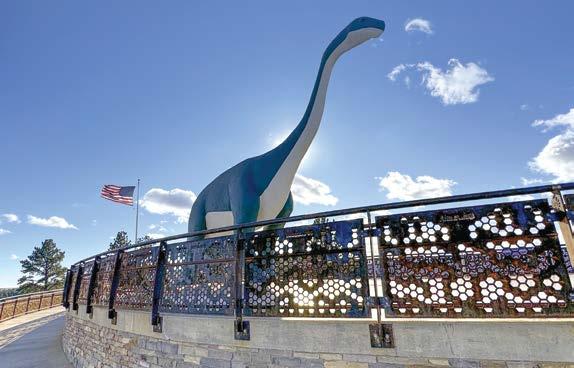
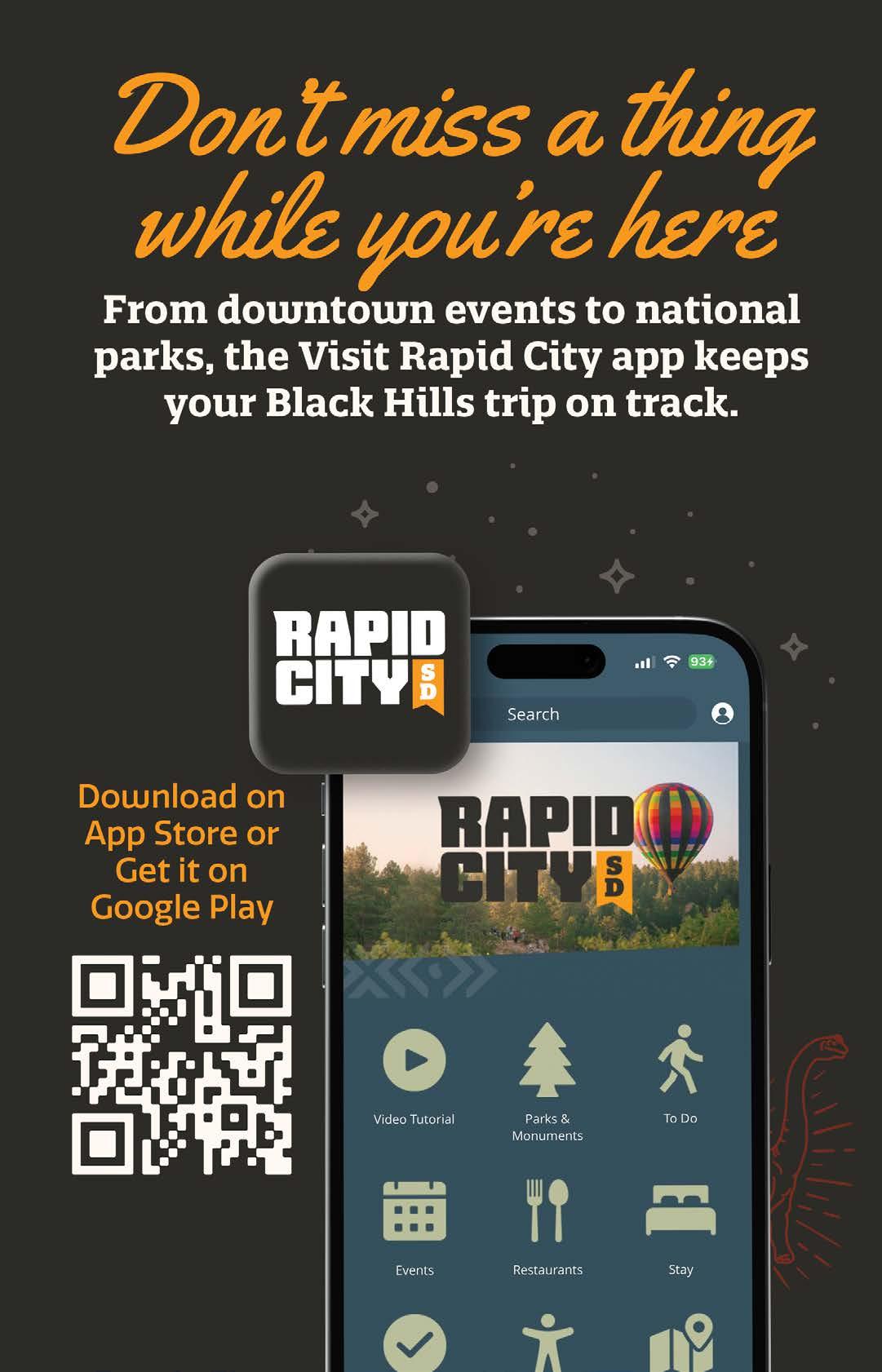
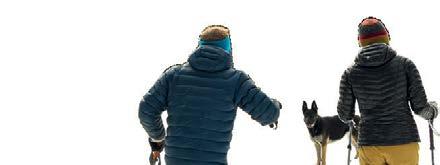
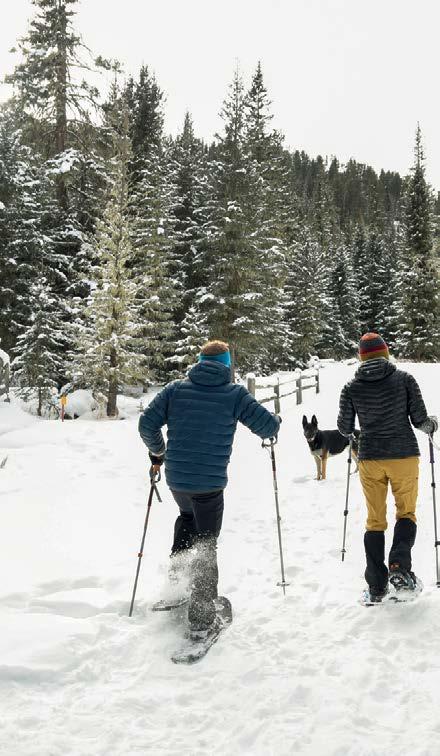
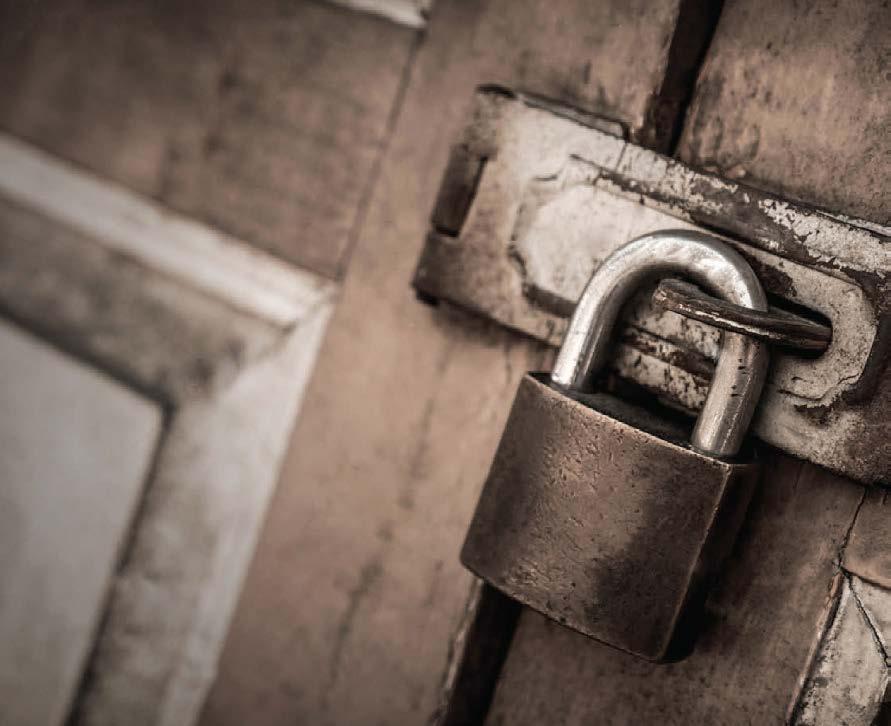


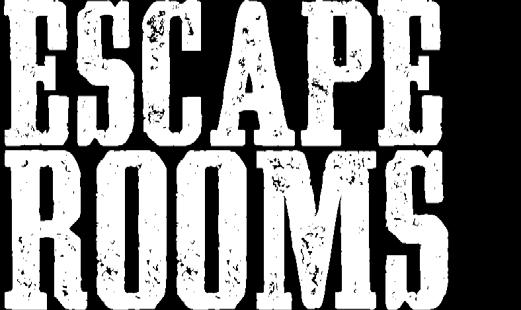

Check
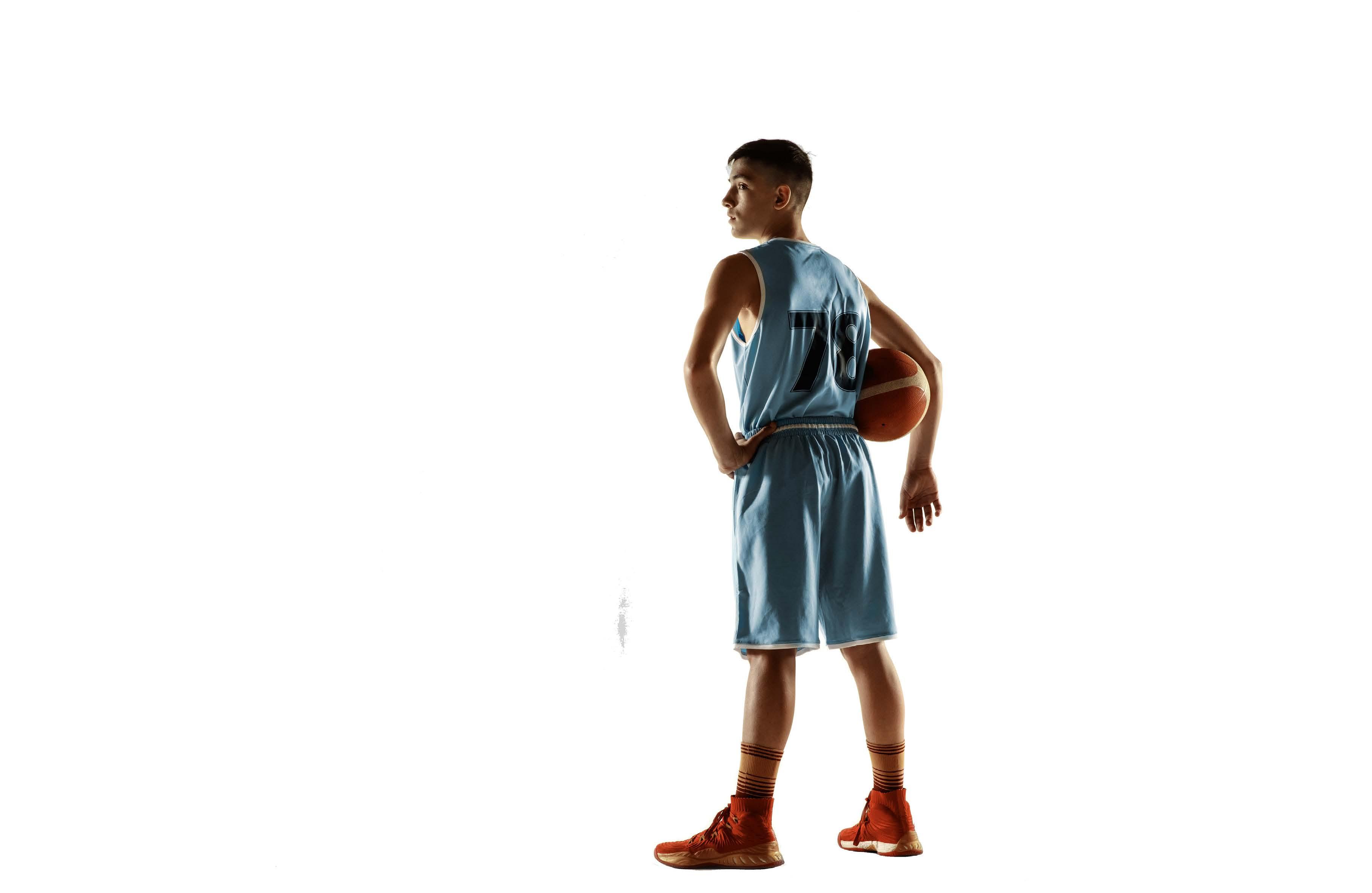

Alex Johnson Hotel ...........G-5
America’s Best
Value Inn G-2
AmericInn I-3
Baymont Inn K-3
Best Western Ramkota ........I-2
Big Sky Lodge .................... F-8
Cambria Suites J-3
Canyon Lake Resort B-7
Comfort Inn & Suites, Mt. Rushmore Rd ...............G-7
Comfort Suites, I-90........... K-3
Country Inn & Suites K-3
Courtyard by Marriott K-3
Days Inn, I-90 I-3
Days Inn, Jackson Blvd....................... E-5
EconoLodge I-2
Fair Value Inn C-4
Fairfield Inn & Suites K-3
Foothills Motel I-3
Garden Cottages Motel C-7
Gold Star Motel I-4
Grand Gateway Hotel I-3
GrandStay Suites ...............G-2
Hampton Inn ....................... I-3
Happy Holiday Motel ........ E-9
Hilton Garden Inn I-2
Holiday Inn
Express, I-90.........................I-2
Holiday Inn Rushmore
Plaza Hotel &
Convention Center G-4
Home 2 Suites-Hilton K-3
Howard Johnson Express ................G-4
LaQuinta Inn & Suites ........ K-3
Lazy U Motel G-7
MainStay Suites J-3
Microtel Inn & Suites I-3
Motel 6 I-3
My Place Extended Stay Hotel K-2
Quality Inn & Suites I-3
Quality Inn G-6
Ramada Inn I-3
Rodeway Inn I-3
Sleep Inn K-3
Staybridge Suites.................I-2
Super 8, I-90 .........................I-2
Super 8, Rushmore Rd G-7
The Nest Hotel H-4
The Rushmore Hotel ..........G-5
Town House Motel .............H-5
Travelodge Rapid City .......G-7
GOLF COURSES
Meadowbrook C-7
Executive ............................ F-4




































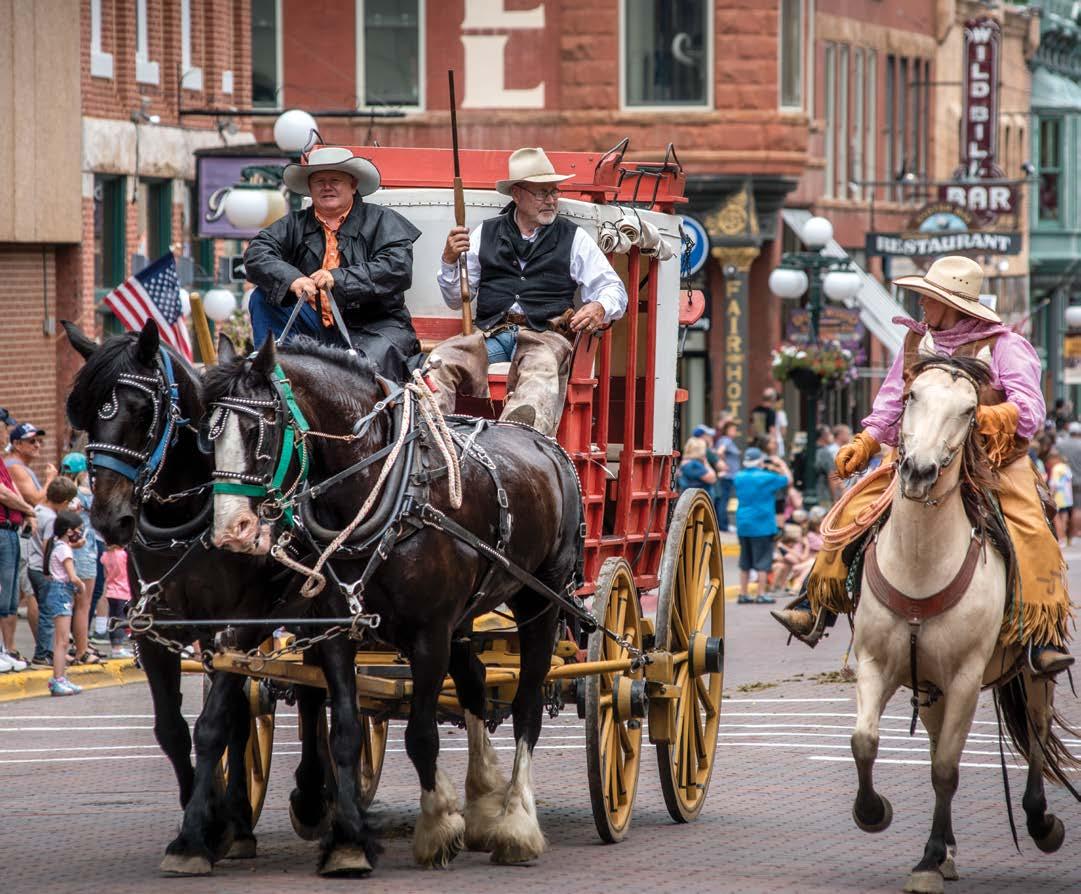
The discovery of gold in a narrow canyon in the northern Black Hills in 1875 brought prospectors, outlaws, gamblers, and prostitutes, turning the outpost into a lawless free-for-all. Many notable figures called Deadwood home for a time, including Wild Bill Hickok, Calamity Jane, Seth Bullock, Potato Creek Johnny, and Al Swearengen. Deadwood’s fortunes have waxed and waned over the decades, with fires
and economic downturns taking their toll. Today, Deadwood is best known for its outdoor activities and casinos. The entire town has been designated a National Historic Landmark District, and its rich heritage is kept alive through historical reenactments and guided tours. Must-see stops include Mount Moriah Cemetery, the Adams Museum, Days of ‘76 Museum, and the Historic Adams House. In the winter, nearby Terry Peak offers skiing, snowboarding, and snowmobiling opportunities.
Deadwood is a very walkable town that is brimming with history. Visitors can discover over 20 interpretive signs while on foot in Deadwood. Each sign will reveal a little bit more of this town’s wild history.

The Black Hills are home to some of the most iconic scenic drives in the country. Before you set out, though, make sure to research whether or not your chosen route is open in the winter.
Named after Lt. Colonel George Armstrong Custer, whose 1874 Black Hills Expedition discovered gold in nearby French Creek, Custer was the birthplace of the Black Hills Gold Rush. It’s also the oldest established town in the Black Hills.
This small community is one of the most beautiful areas in the Black Hills, with an extensive network of trails and back country roads. It’s just a short driving distance from Mount Rushmore, Crazy Horse Memorial, and Jewel Cave National Monument. Custer State Park, known for its pristine lakes, granite rock formations, and abundant wildlife, lies just north and east of the city. Visitors will find a robust local food scene, art galleries, and museums.
This early mining town embraced tourism in 1927 when sculptor Gutzon Borglum chose nearby Mount Rushmore as the location for his monument to four American presidents. Today, Keystone boasts family-friendly attractions and a chance for some great indoor fun in a turn-of-the-century setting. Nearby Iron Mountain Road, with its famous “pigtail” bridges, is a favorite scenic drive.
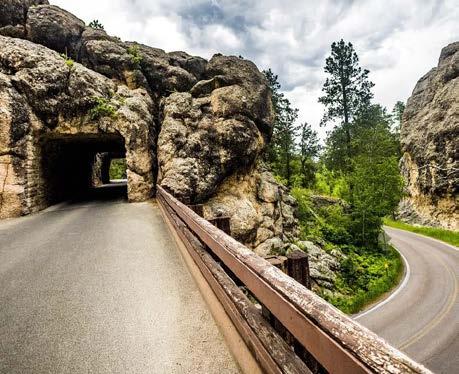
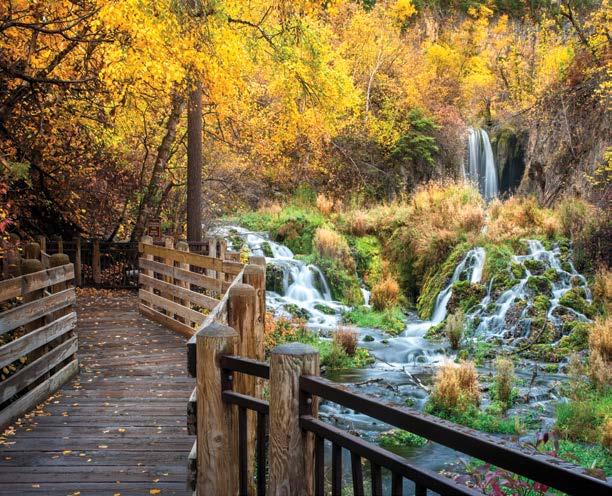
Like many Black Hills communities, 1876 was a pivotal year for Spearfish. Originally called Queen City, it was later renamed after the fast-flowing creek where fish were “speared” by Native American tribes. The town was founded to supply food to the mining camps in the Northern Hills. Its location in a broad valley gave rise to an agricultural industry that helped the town diversify beyond a dependence on mining. With 11,000 year-round residents and 5,000 students who attend Black Hills State University, Spearfish is the second-largest community in the Black Hills and one of the fastest-growing “micropolitans” in the Midwest. Its natural beauty and a quaint downtown perfect for leisurely strolling offer experiences for everyone. The town’s location at the mouth of Spearfish Canyon makes it the perfect launching point for outdoor adventures. Shops, galleries, restaurants, and brew pubs have transformed the community into a yearround destination.
Spearfish set (and still holds) a world record on January 22, 1943: temperature jumped 49°F in two minutes due to Chinook winds. Learn more about the wild weather of the Black Hills by scanning the code below.
Founded in 1876 by Fred and Moses Manuel, Lead (pronounced LEED) was named after the rich vein of ore discovered here. They staked a claim and established the Homestake Gold Mine along with Hank Harney and Alex Engh, which operated for 125 years. Today, the site houses the Sanford Underground Research Facility (SURF), dedicated to furthering scientific discovery through experiments conducted 4,850 feet below ground. In the winter, Lead’s ample snowfall attracts winter sports enthusiasts.

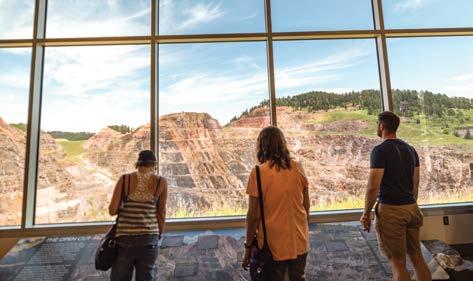
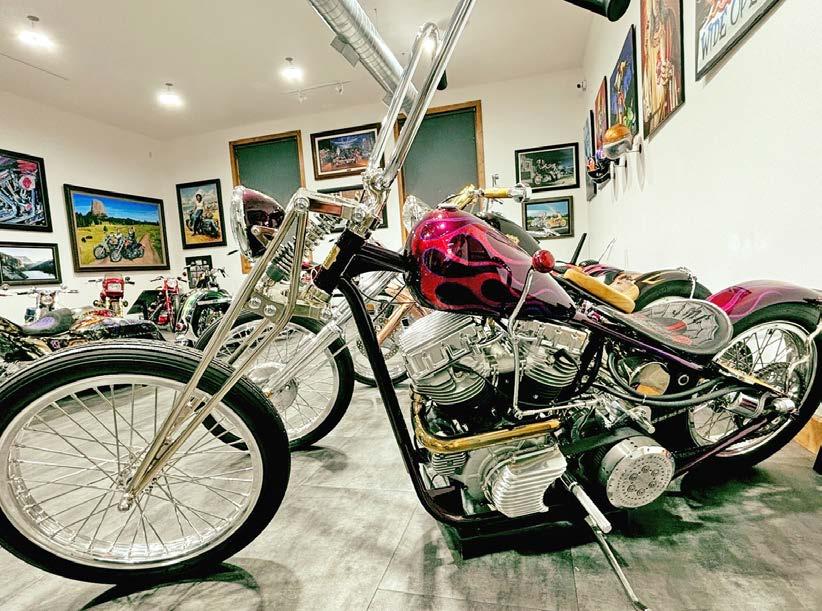
with
In 1878, Sturgis was established to provide goods and services for nearby Fort Meade, an outpost for the 7th Cavalry until 1944. The Black Hills National Cemetery was established in 1948 to provide a final resting place for veterans and their spouses.
The natural warm waters that inspired its name have drawn people to Hot Springs for centuries. Early settler Fred Evans envisioned turning the entire town into a health spa.
Hot Springs is home to the largest Columbian mammoth exhibit in the world, and its historic downtown offers visitors a glimpse of early pioneer life and unique sandstone architecture. Kids and adults alike will enjoy a plunge into the 87-degree mineral waters of the local indoor pool. Wind Cave National Park and Angostura Reservoir are also a short drive from the Gateway to the Southern Hills.
Today, the town of 6,900 is best known for its annual motorcycle rally. During the offseason, you can still get your fill of Harleys at the Sturgis Motorcycle Museum, or check out the public sculptures and unique dining options.
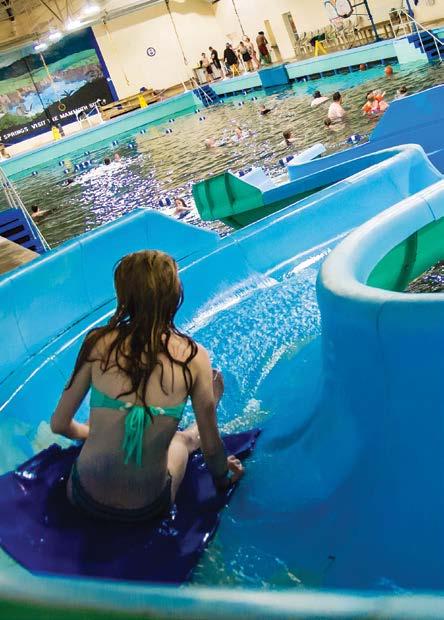
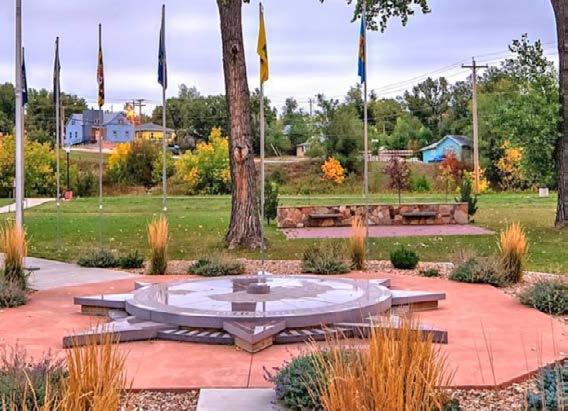
French for “beautiful fork,” Belle Fourche (pronounced BellFOOSH) lies at the confluence of the Belle Fourche and Redwater Rivers. Seth Bullock, the former sheriff of nearby Deadwood, bought up land and enticed the railroad to build a depot here, offering free right-of-way and a new terminal. Belle Fourche soon thrived, becoming the world’s largest livestock-shipping point for a time. Belle Fourche remains an important agricultural hub serving the Tri-State Area (NW South Dakota, NE Wyoming, and SE Montana), and with the addition of Hawaii to the union, became the geographic center of the nation. Visitors to this pioneering town can enjoy antique shops, museums, locally owned restaurants, and a flag-lined walking path along the Center of the Nation Monument.
Hill City is the second-oldest community in the Hills and was known as “a town with a church on each end and Hell in between.” Its location near the center of the Black Hills inspired its moniker, “The Heart of the Hills.” The town has evolved into a thriving arts community, with shops, museums, and other attractions. Visitors can experience the rumble of a locomotive as it felt a century ago when riding the steampowered 1880 Train through the Black Hills, or relax in a local winery or craft brewery located within a few miles of the town center.
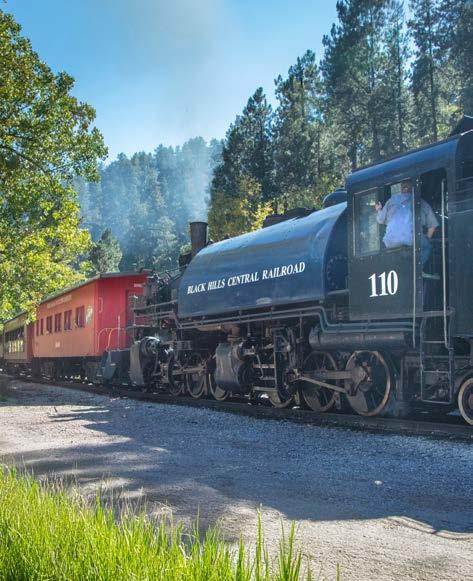
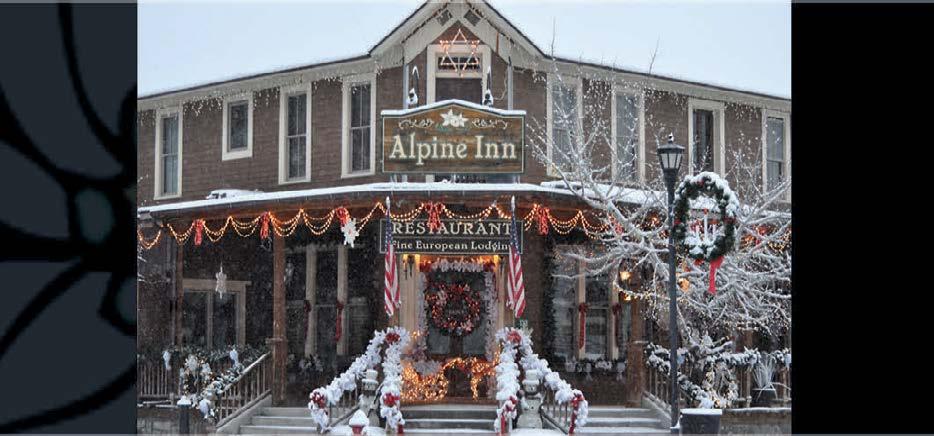
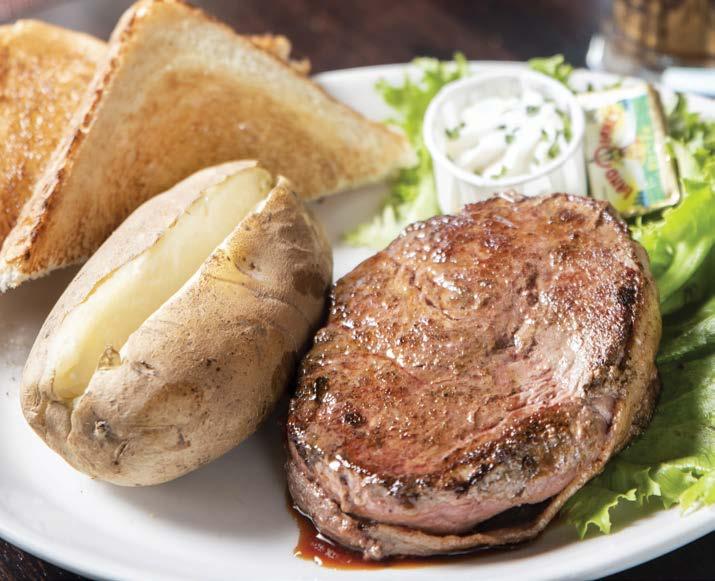
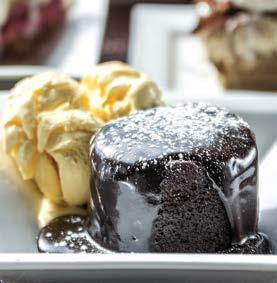
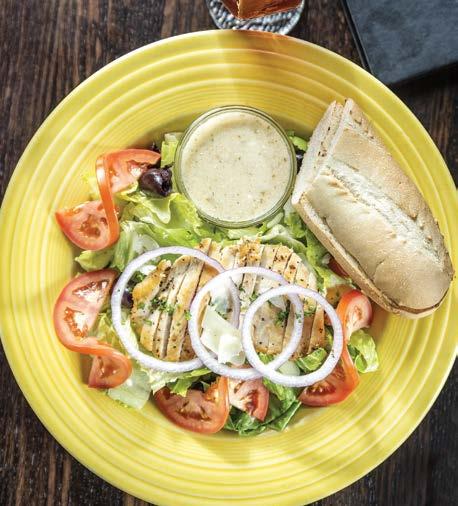

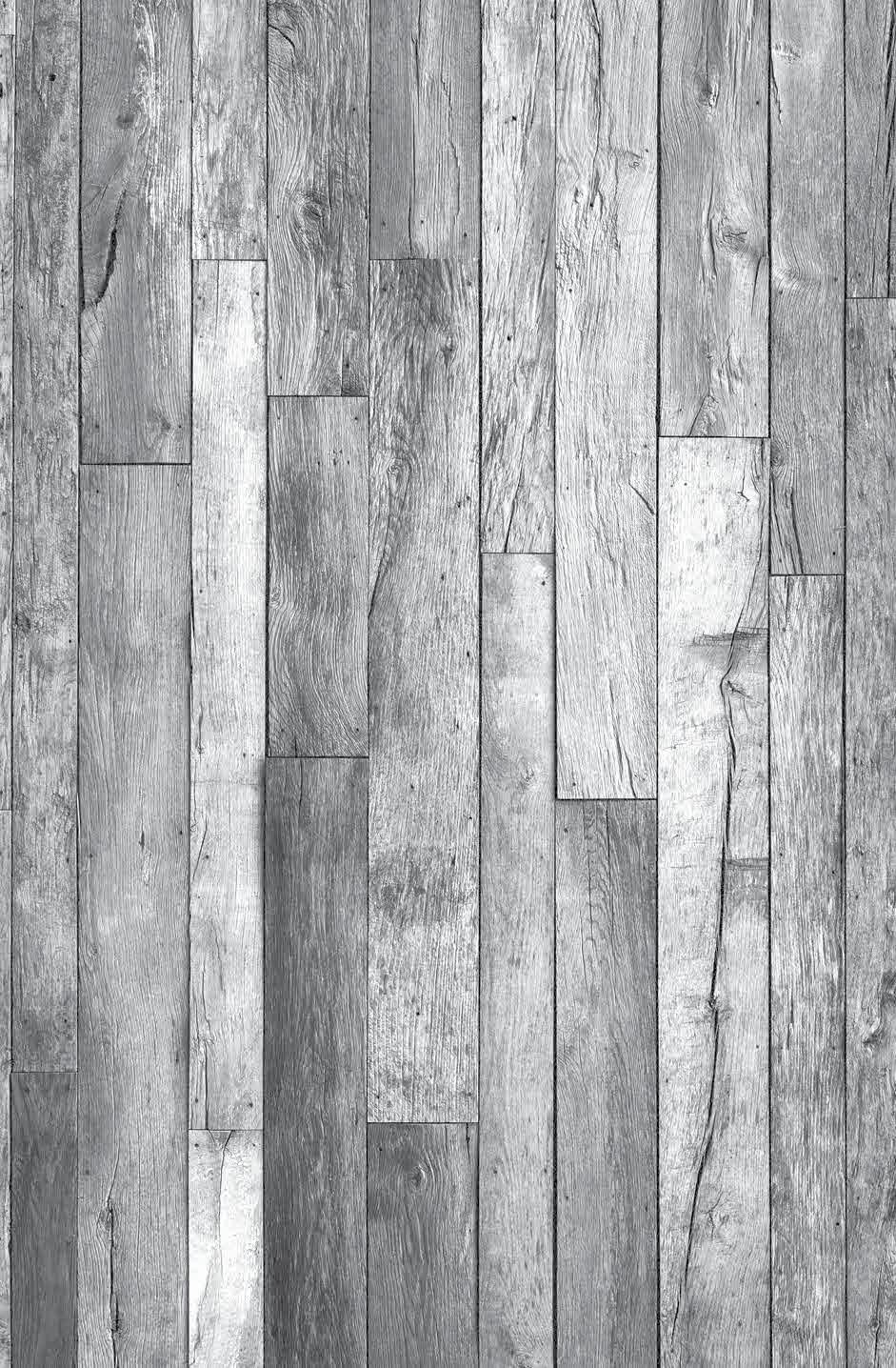

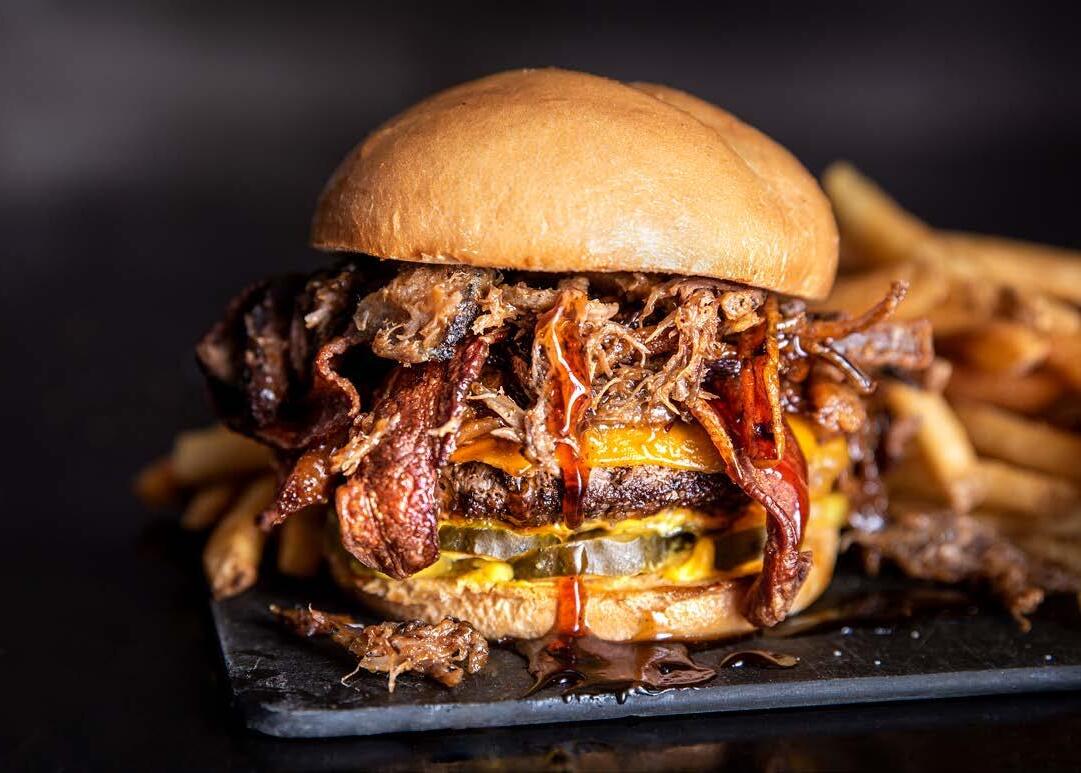
The saying “eat, drink, and be merry” is especially true when you’re on vacation. No matter if you’re a die-hard foodie or casual nosher, some things should just be tasted right from the source. Make meals a central part of your Black Hills adventure by trying dishes unique to the area and experiencing things you normally wouldn’t try. We’ve chosen a few iconic South Dakota experiences you won’t want to miss during your time in the region.
TAKE IN THE MONUMENTS and dine with four of the nation’s presidents at Mount Rushmore National Memorial in Keystone and Chief Crazy Horse at Crazy Horse Memorial® near Custer. Enjoy delicious cuisine from a homey breakfast to a full-course gourmet meal, while you sit in front of a cascading wall of windows showcasing one of the magnificent carvings and admire the work in front of you.
your sweetheart? The Black Hills boasts a variety of dining options perfect for a nice evening or celebration. Get dressed up and enjoy a unique combination of ingredients, textures, and tastes crafted by award-winning chefs located in Deadwood, Rapid City, Custer, and beyond!
SAVE YOUR SEAT at one of our small local diners, restaurants, and eateries. Although quaint, these venues are packed with unexpectedly big flavors—which makes them popular with locals. Many places take reservations, but even if there’s a line out the door, take a chance and wait! Most lines go quickly, and you’ll be pleasantly surprised by the variety of homestyle cooking you’ll find.
GO SKY HIGH and enjoy your lunch or dinner on a rooftop bar or patio. The scenery, urban sounds, and delicious plates will be the perfect culinary experience your trip is looking for.
FIND A FOOD TRUCK in Rapid City! There are numerous vendors with an array of eats from Jamaican, Mexican, and American favorites like stuffed burgers, cheese steaks, and BBQ. Where are they hiding? They are typically parked near one of the local craft breweries,

by a park, or even at events throughout the Black Hills. Follow along on Facebook to discover local favorites and find out where they’re parked during your stay.
TASTE A LITTLE BIT OF EVERYTHING by going to a buffet-style diner. These restaurants are an excellent option, especially for picky eaters. From homestyle favorites to seafood platters and sushi bars, you’ll find the perfect fit for your travel group no matter which community you’re in.
PIZZA is a local favorite everywhere, but in the Hills we do things differently. If you can think of a concoction of flavors, you’re likely to find it here. We’ve got jalapeno popper pizza, mashed potato pizza, cheeseburger pizza, and the increasingly popular Reuben
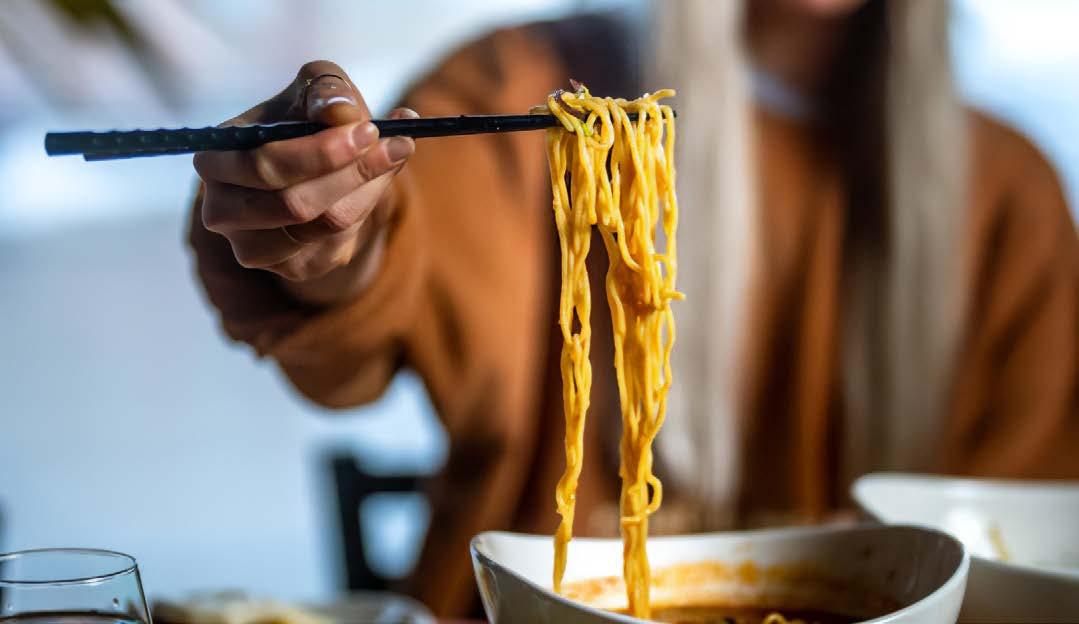
pizza. Thick crust, thin crust, cauliflower crust, glutenfree—we have it all. Pair your pizza with a Black Hills craft brew and you have a dinner of champions!
RAMEN is a traditional and trendy Japanese dish that has taken the Black Hills’ largest city by storm. In recent years, multiple ramen restaurants have popped up in Rapid City. Ramen is a dish that is certainly a welcome addition to the Black Hills, especially in the chilly months of fall and winter. This brothy, noodly soup is served in a variety of ways and is much more subtle and complex than its instant and store-bought counterpart. Some local ramen joints have even incorporated iconic Black Hills ingredients
The Black Hills are known to both foragers and gourmets for its mushrooms. Many restaurants throughout the Black Hills feature these locallyforaged fungi in their dishes.
Remember, don’t try foraging for mushrooms unless under the direction of an experienced guide.
into their preparation. So, don’t be surprised to find bison bone broth, chislic or locally foraged mushrooms when you order a bowl of ramen here in the Hills.
SWEET TOOTH’S HAVEN IS HERE! If you need something sweet and unique, try one of the artisan desserts at The Sour in Downtown Rapid City. Or maybe enjoy homemade fudge, turtles, or caramel apples at one of the many candy and chocolate stores in the Black Hills. Truffles are a Black Hills favorite, and you’ll find each town has their own specialty the locals swear by.
Try a scoop of homemade ice cream at a parlor in every town you visit—many of them use fresh, local ingredients or
Brewmasters in the Black Hills swear the local water gives their beer a unique flavor. These craft brews truly are one-of-a-kind drinks you won’t want to miss.
have secret recipes. Some even pair up with bakeries to deliver a new twist on classic frozen treats. No matter where you go in the Black Hills, you will find sweet memories to cap off the perfect dining experience.
BEER New breweries pop up in the Hills every year, offering a variety of craft beer and guided tours of their facilities. Many use local ingredients, so you’ll find something new to love.
Breweries and taprooms can be found all over the Black Hills. Patrons can enjoy delicious craft beers in styles including ales, lagers, stouts, sours, and more.
BEERS, some of which feature locally grown, hand-picked ingredients when you visit. Summer brews like lagers and wheat beers feature honey or floral herbs, but as the season begins to change, enjoy heavier porters, stouts, and IPAs with heavier spices and seasonal ingredients.
BREWERIES all over the Black Hills offer a variety of guided
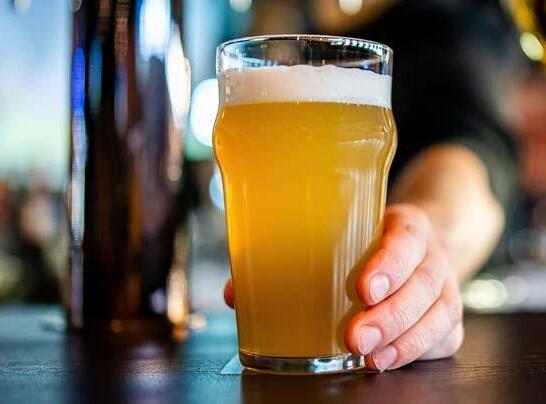
Bison is one of the most popular menu items to try during your trip to South Dakota. The meat has a slightly sweet yet rich flavor, is very low in saturated fat, and naturally loaded with nutrients. Appetizers such as skewers and main course meals like burgers and steaks are common.
For the best flavor, order your bison medium-rare to rare; with such a low fat content, the meat will dry out fast the more it’s cooked.
The Black Hills are a melting pot of cultures, especially when it comes to food. Scan to find out what other cultures have shaped the culinary landscape of the region.

tours that give you a front row seat to behind-thescenes action. Many also offer a variety of choices for beer tasting. Watch for both free individual samples and beer flights—a rack of four or more testers, usually for purchase. Most breweries will also fill a growler or crowler of your favorite tap for you to take to-go and enjoy later.
COCKTAILS Enjoy a martini, margarita, or whatever you can imagine at local spots throughout the Black Hills. From high-class clubs to laid back bars, the mixologists at each venue in the communities around the area have prepared unique concoctions you’re sure to enjoy. Many use
Black Hills tasting rooms tend to be a laid-back experience. Personable, well-informed guides will introduce you to the wines the winery produces, along with the local stories behind each label. Many offer free tastings, and some even allow you to make reservations ahead of time if you have a large group. If you want to make a day of it, the Black Hills Wine Trail along Highway 385 connects the charming tasting rooms in Hill City to those in Deadwood.
spirits from around the Black Hills and South Dakota, not to mention local ingredients that give these special cocktails an extra flair. Watch for patios with incredible views to take in a uniquely Black Hills experience.
bring back memories of the roaring 20s when the Wartime Prohibition Act put a ban on the sale of all alcoholic beverages. While Prohibition has long since passed, the feel of speakeasies and lounges lives on. Today, there are a handful of distilleries where you can experience one-of-akind liquors. From whiskey and bourbon to vodka and rum, tasting the local


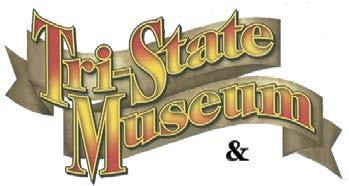
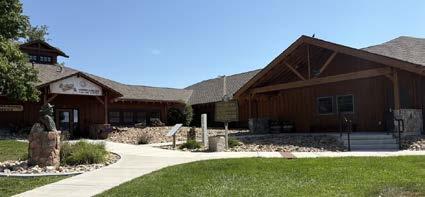

1. Crow Peak Brewing Co.
2. Sawyer Brewing Co.
3. Spearfish Brewing Co. STURGIS
4. The Knuckle Brewing Co. DEADWOOD
5. Sick-N-Twisted Brewing Co. LEAD
6. Dakota Shivers Brewing Co.
RAPID CITY
8. Lost Cabin Beer Co.
9. Dakota Point Brewing
10. Hay Camp Brewing Co.
11. Firehouse Brewing Co.
12. Zymurcracy Beer Co. 13. Last Mile
Cohort
15. Firehouse Brewing Co.
17.Sick-N-Twisted Brewing Co. CUSTER
18. Mt. Rushmore Brewing Co. DISTILLERIES DEADWOOD
19.Deadwood Distillery
RAPID CITY
20. Contraband Distillery WINERIES STURGIS
21. Belle Joli Winery DEADWOOD
22. Naked Winery
23. Belle Joli Winery Tasting Room
RAPID CITY
24. Firehouse Winery
HILL CITY
26. Naked Winery
27. Twisted Pine Winery
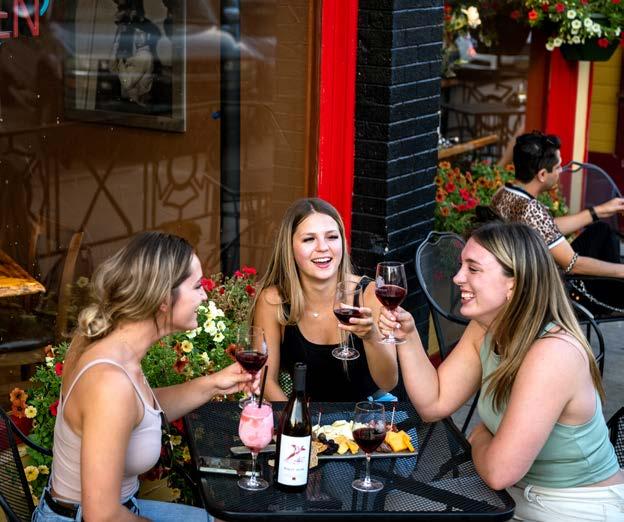
flavors of moonshine the area has to offer is an experience all its own.
WINE The wineries located in and around the Hills provide the perfect excuse for you to explore something other than the typical. Whether you are a “grape novice” or an experienced wine connoisseur, you will love tasting the different flavors available here.
Wineries in the Hills aren’t as prolific as breweries, but they’re worth going out of the way for; each of them have created awardwinning wines at the national and international levels.
GET THE FULL EXPERIENCE at local venues that host events throughout the year. Visitors can experience stand-up comedy shows— from open mic nights to nationally acclaimed comedians—as well as themed food-and-drink pairing dinners.
If live music is your thing, you can find musicians performing around the Hills at bars and clubs almost any night of the week.
LIVE A FULL LIFE, YOU HAVE TO FILL YOUR STOMACH FIRST, as some have said. The same could be said for vacation: to pull off the perfect getaway, you have to find the perfect meal. And here in the Black Hills, you’re sure to find a perfect meal or two, along with some delicious drinks. It’s all a part of the experience.
South Dakota doesn’t have an official cocktail, but if it did, The President would fit the bill. This combination of light rum, orange juice, and grenadine is smooth and citrusy, perfect for sipping after a visit to Mount Rushmore. Ask your bartender to whip one up!
Love the flavor of cocktails but looking to cut back on calories? Order your favorite drink as a mocktail instead. Most bartenders are happy to make nonalcoholic versions of classic drinks, substituting ingredients like club soda and apple cider. Some are so flavorful you might never go back to your oldfashioned Old-Fashioned!
Looking for a place to dine? Whether it’s a quick bite to eat or something with western flavor and charm, search our listings to find the perfect dining experience for you.





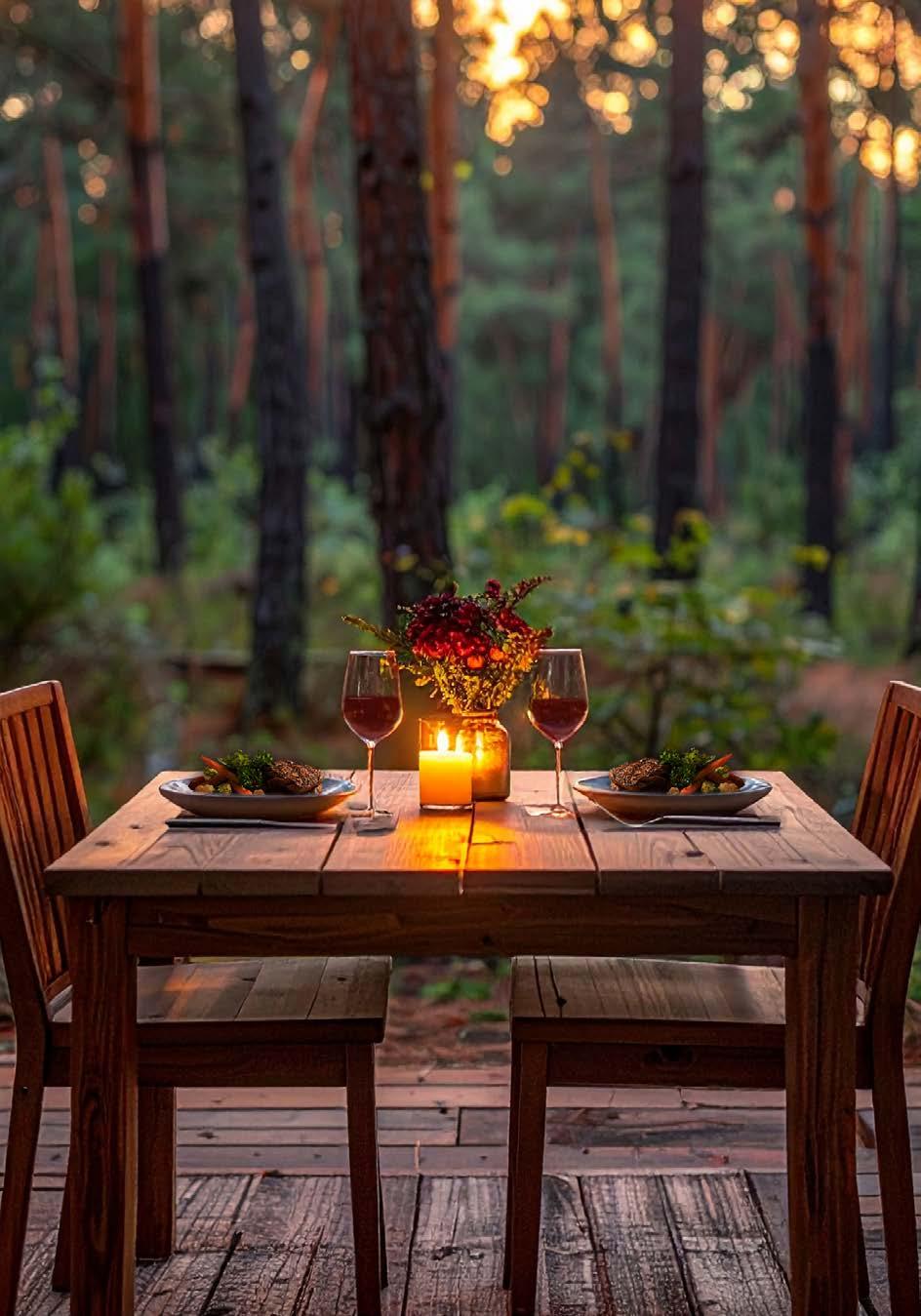
BREAKFAST
LUNCH
DINNER
COCKTAILS
BEER




WINE
TAKEOUT
DELIVERY
CHILDREN’S MENU
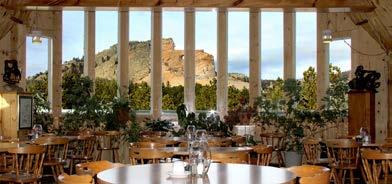
CUSTER
Laughing Water Restaurant® at Crazy Horse Memorial® 605.673.4681
Everyone’s favorite comfort foods






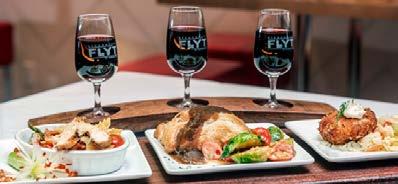
DEADWOOD
FLYT Steakhouse by Alpine Inn 372 Main Steet 605.571.1500
Sure to satisfy any craving!






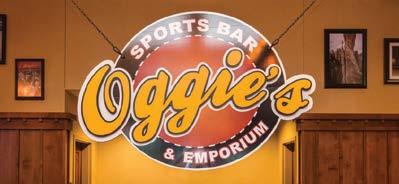
DEADWOOD
Oggie’s Sports Bar & Emporium 100 Pine Crest Dr. 605.571.2120
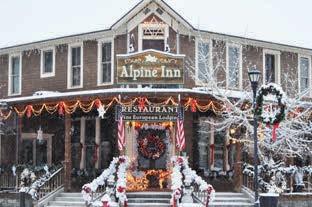
Stop in for Good Food and Great Times! HI






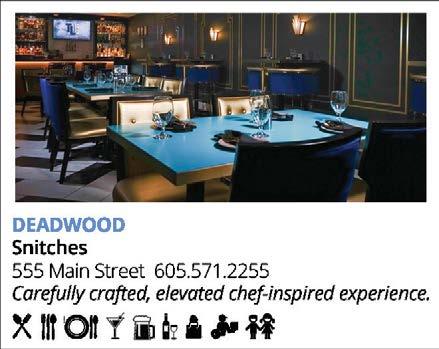
DEADWOOD
Snitches 555 Main Street 605.571.2255
An Elevated Culinary Experience







Alpine Inn 133 Main St. 605.574.2749

Lunch: Mon - Sat, 11am to 2:30pm
Dinner: Mon - Thurs, 5pm to 9pm | Fri - Sat, 5pm to 9:30pm




Homey atmosphere steeped in old-world charm




The Latchstring Restaurant 10619 Roughlock Falls Rd, Lead. 605.584.3333 Cuisine that is as magnificent as the scenery.






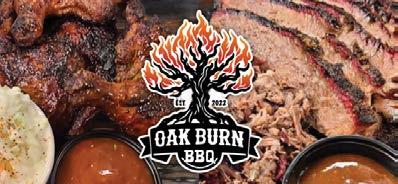
RAPID CITY
Oak Burn BBQ 821 Fairmont Blvd, Rapid City 605.390.8821
Rooted in the rich tradition of Texas barbecue.








RAPID CITY
Sliders Bar & Grill 1416 N. Elk Vale Rd. 605.718.2445 A bar with a slide running right through it!






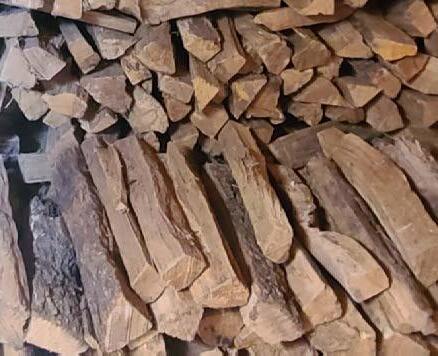
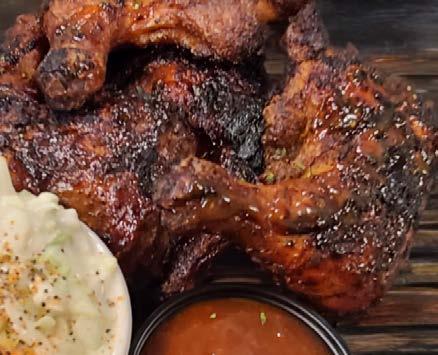
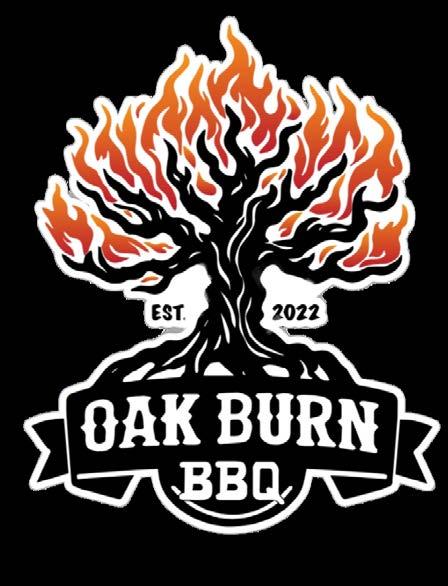
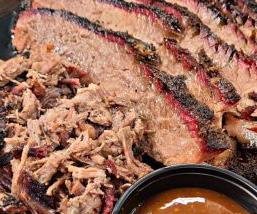

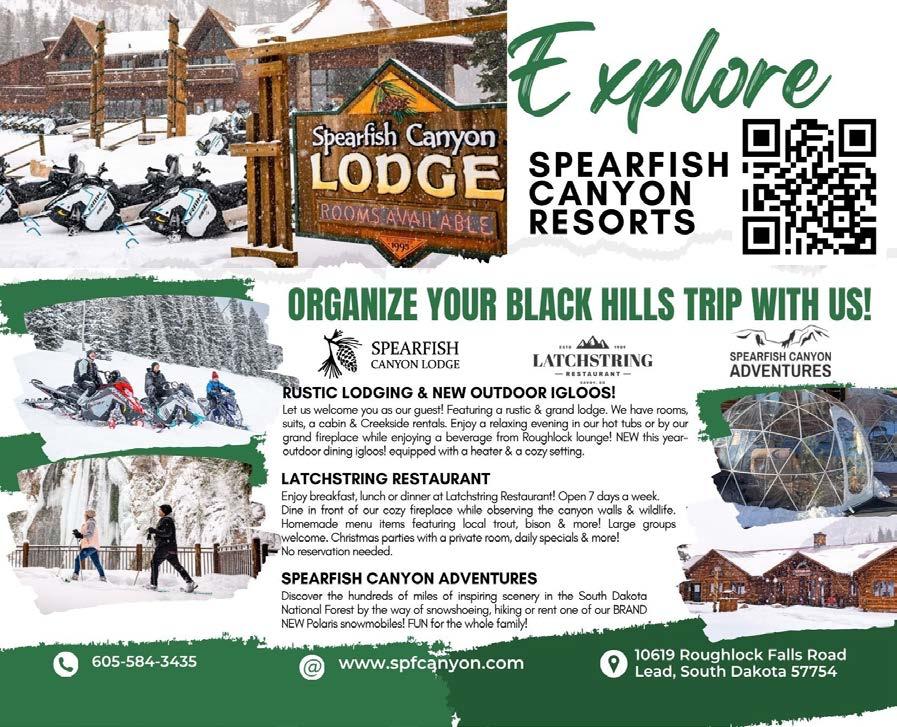
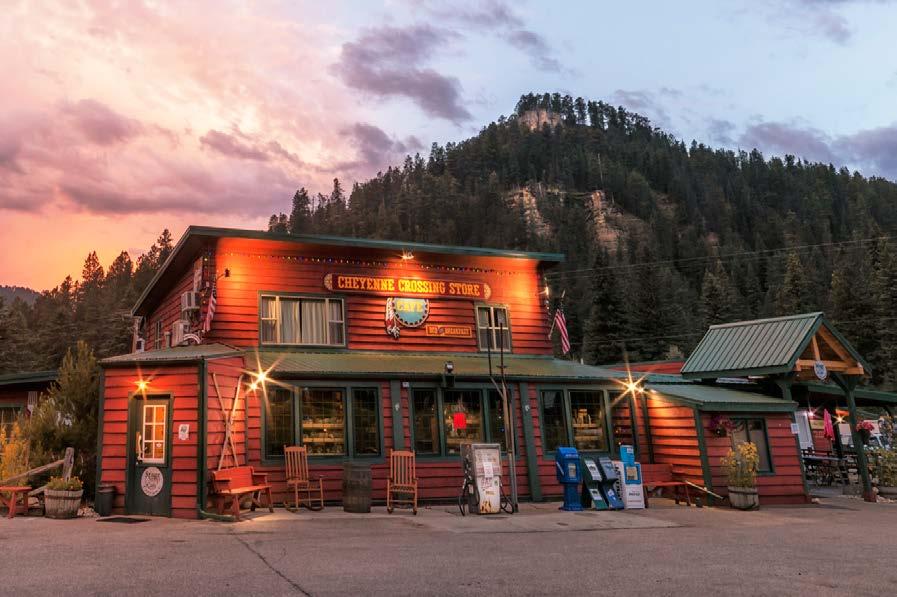





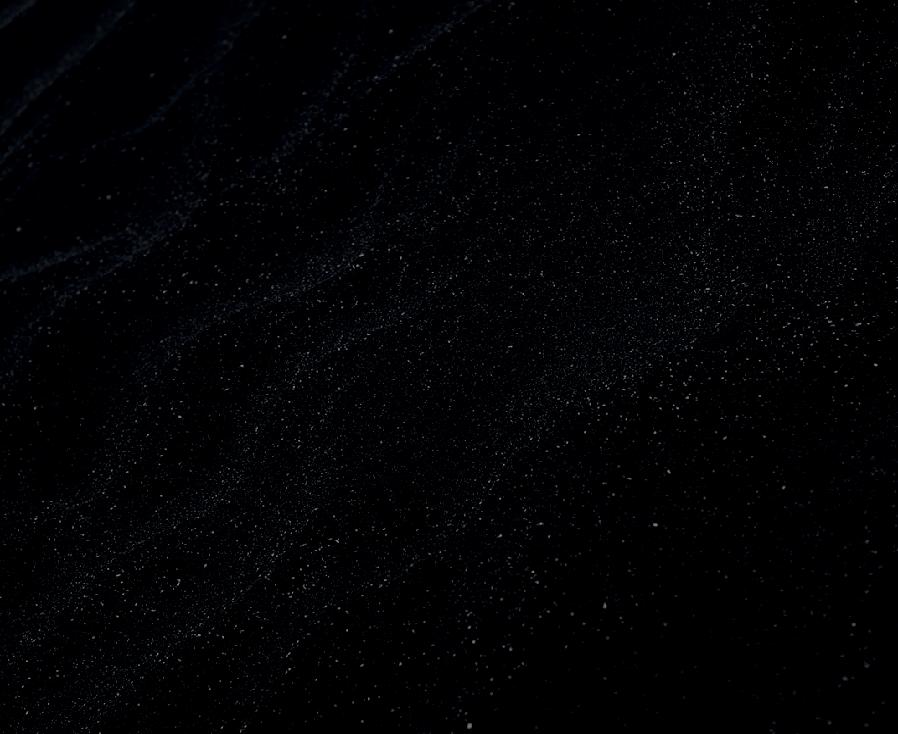
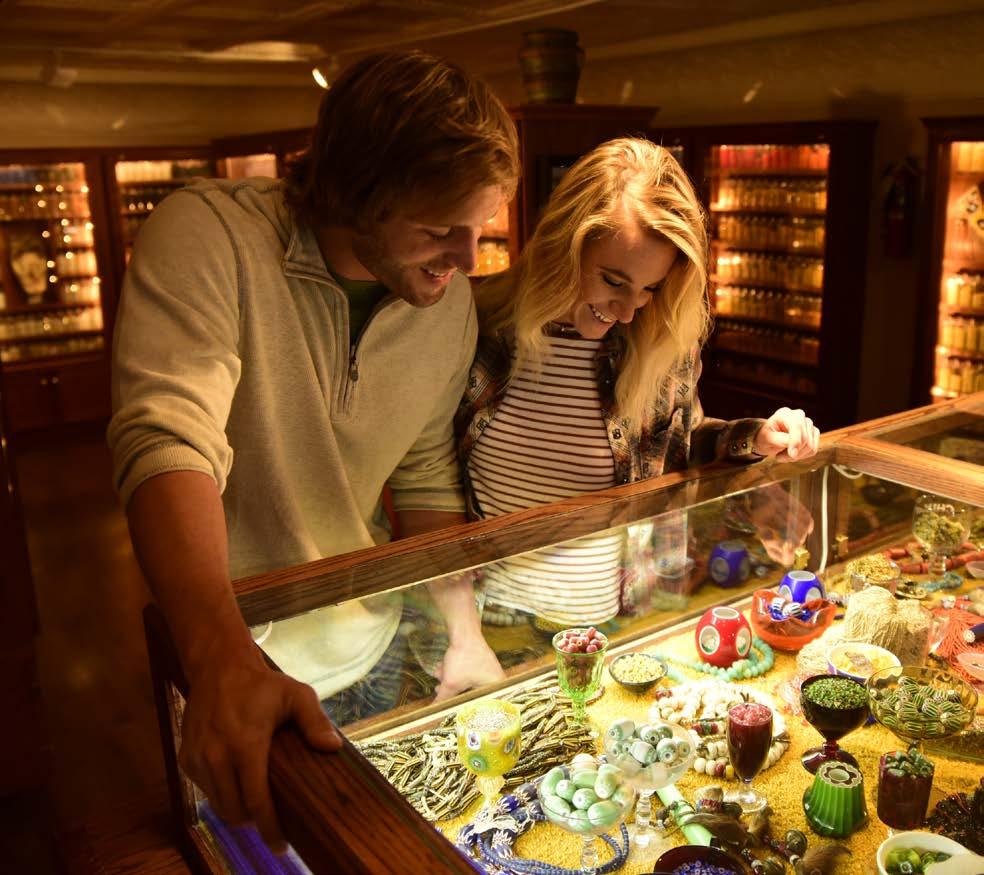
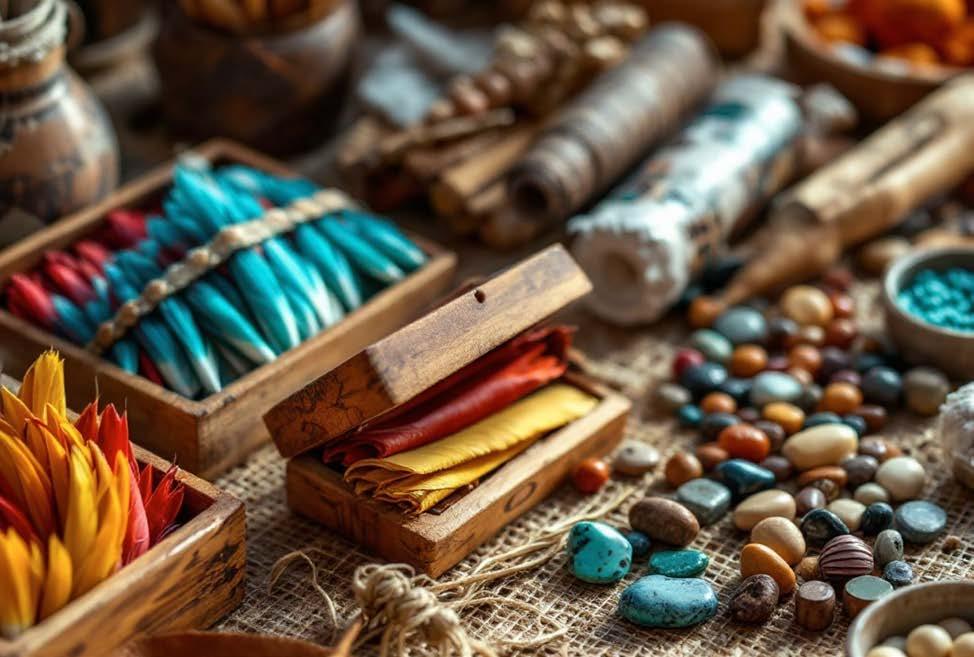
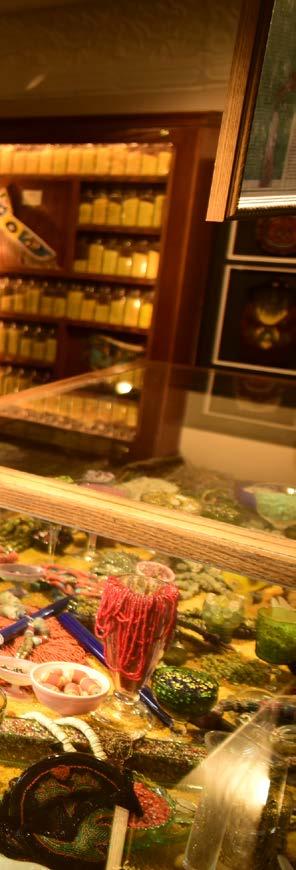
VACATIONS ARE FILLED WITH MEMORIES , and you’ll have great stories to share after your trip to the Black Hills. Whether you tour museums and monuments, relax at the cabin, hit the slopes, or try your luck in the casino, you’ll always carry a little piece of South Dakota that will be remembered for a lifetime. As unforgettable as these experiences will be, it’s also fun to capture them in a way that can make great keepsakes.
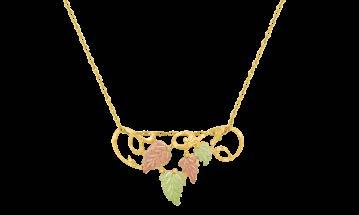
1874
BLACK HILLS GOLD is a treasure from the source. The manufacturers of Black Hills Gold jewelry create a diverse selection of pieces that can be produced only here. The signature hues are created by mixing pure gold (yellow) with copper (for pink) and silver (for green). Artisans then design their own patterns of grapes, leaves, and stems; they often include gemstones, as well. Feel secure that shops marketing Black Hills Gold are legitimate dealers—and then add a bit of sparkle with diamonds, sapphires, or aquamarine.
ARTISTS FROM OUR LOCAL AREA , as well as regional and national talents, show their work at art galleries, museum shops, and boutiques in towns throughout the Hills. Discover traditional instruments, original paintings and prints, bronze and mixed-media sculptures, pottery, leatherwork, textiles, clothing, handmade jewelry, soaps, or candles.
FOR A CHILD , or if your family is with you, you’re in the right spot. Bookstores, children’s boutiques, and toy stores are scattered throughout each of the Black Hills communities and are a great way to make their trip extra special.
WINE, AND BEER are also local specialties that make great gifts or personal indulgences. Create a unique and personalized gift basket with smoked pheasant, turkey, buffalo, elk, and beef salami combined with cheese, sweets, and snacks. Don’t forget locally made wines and beers.
Can’t fit your gift into your luggage for the flight home? No worries! Ask the retailer for their shipping options.
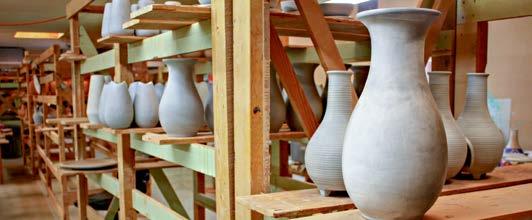
Made from the red clay found in the Black Hills, this pottery holds deep significance for many Native American tribes. Each piece is handcrafted by skilled Indigenous artists, who incorporate intricate designs and symbols that are meaningful to their culture. These unique artworks are often displayed in local stores, where you can explore and admire the craftsmanship. Many of these pieces are also available for purchase.
Lakota or Sioux? These terms are often used interchangeably, but which is preferred?

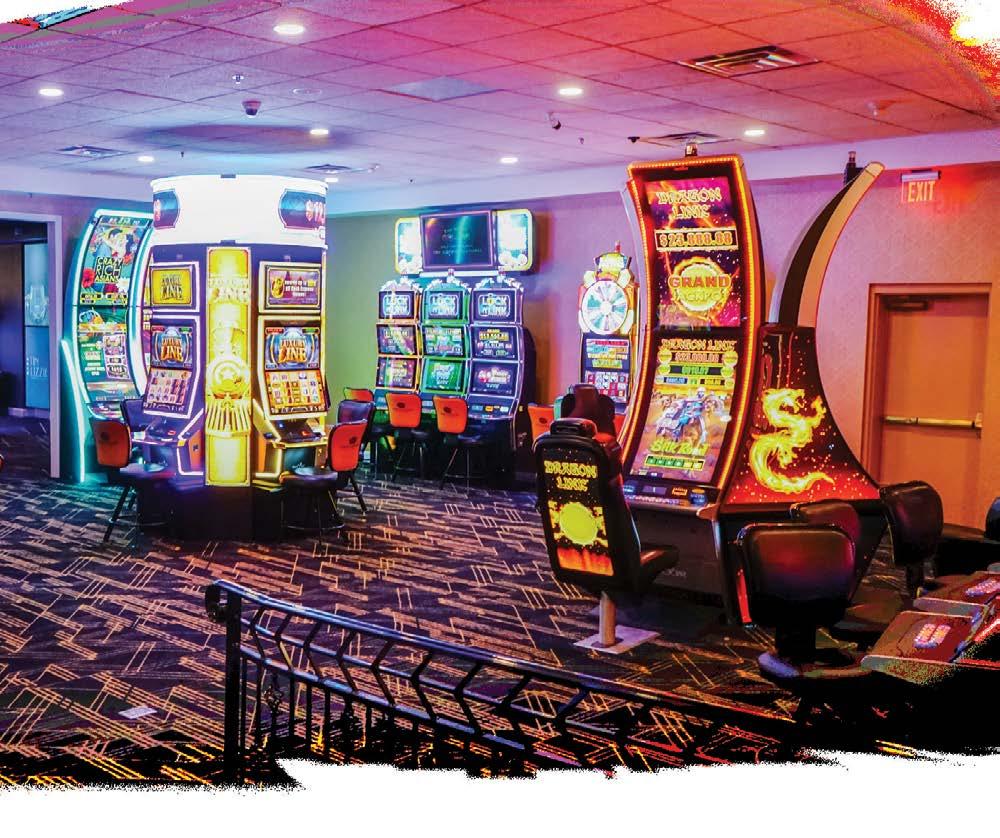



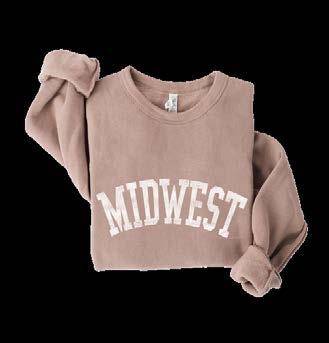
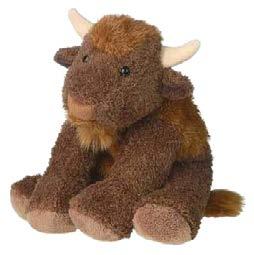

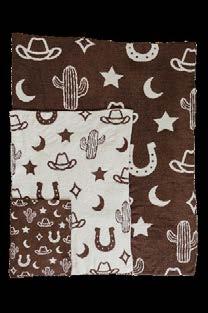
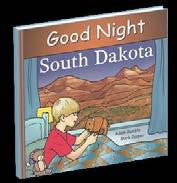
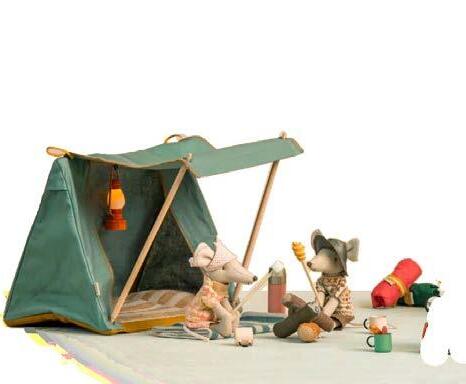
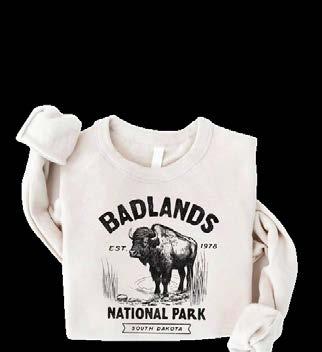

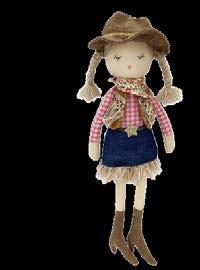

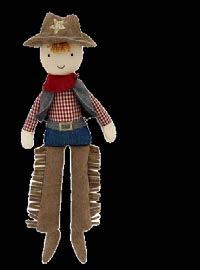







Lt. Col. George Armstrong Custer and his 7th Cavalry were dispatched to the Black Hills in 1874 to establish a fort and search for a new trade route. The discovery of gold in French Creek marked the beginning of the Black Hills Gold Rush.
Miners began flooding into present-day Keystone in 1876 after gold was discovered in Battle Creek. Extracting the gold proved difficult, and most miners left to try their luck elsewhere. More gold was found in 1891, breathing new life into the community.
With the 1876 discovery of a gold-bearing creek in a gulch full of dead trees, attention shifted to the Northern Hills. The town of Deadwood sprang up overnight, attracting miners, gamblers, and gunslingers. Lawlessness prevailed until Seth Bullock was appointed sheriff.
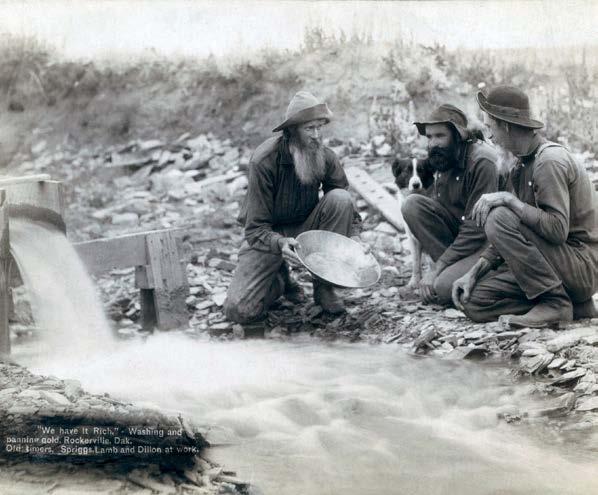
Lead was founded in 1876 when a rich vein of gold was located three miles south of Deadwood.
A year later, a group of investors led by George Hearst purchased the Homestake Gold Mine, which would become one of the most prolific gold mines in the world.
A group of gold miners staked a claim along Spring Creek in 1876. The settlement, named Hill City, eventually proved better suited for tin mining.
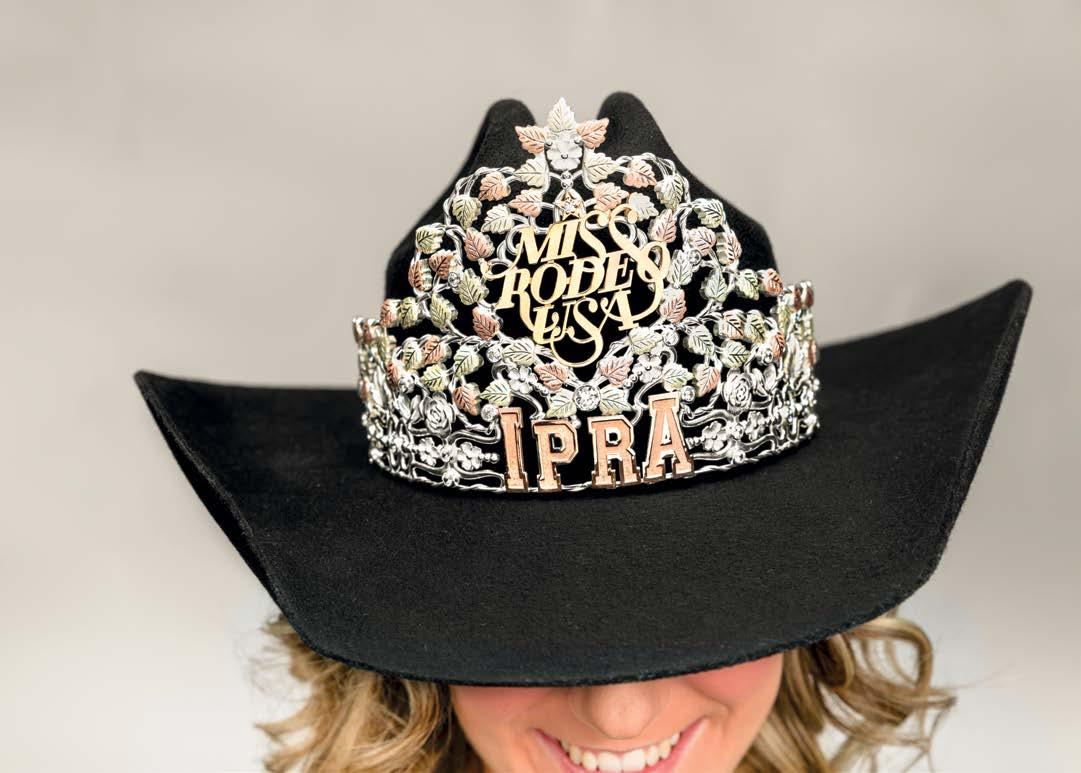
Originating from a legend, Black Hills Gold jewelry has ultimately become one of the area’s most recognized and collectible products. The familiar tri-colored leaf and grape design of Black Hills Gold has become a symbol for over the past century and into the new millennium.
It is widely acknowledged that a would-be gold prospector named Henri LeBeau was the father of Black Hills Gold’s distinctive pattern. The legend of the design is attributed to a dream said to have been experienced by LeBeau while
he was wandering in the Hills in the late 1870s. Upon falling asleep in a remote location in the northern Black Hills, LeBeau dreamed of a creek with numerous grape vines growing along its banks. When he awoke, he stumbled over the next hill to see a scene much like the one in his dream. LeBeau later began making a line of jewelry reflecting this dream and went on to train many of the early Black Hills craftsmen in this style of design now known as Black Hills Gold jewelry.
a




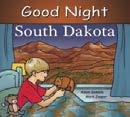



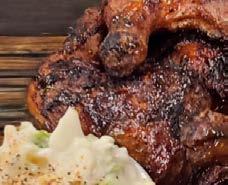
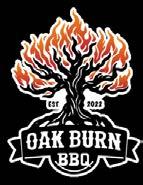
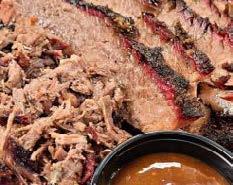

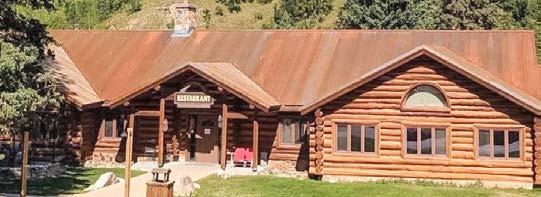



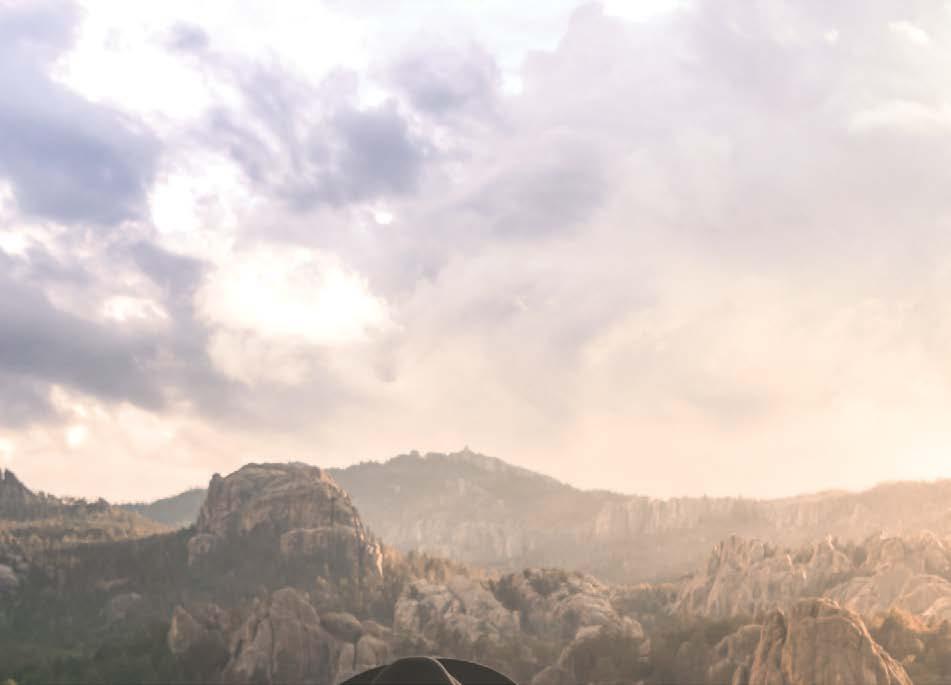


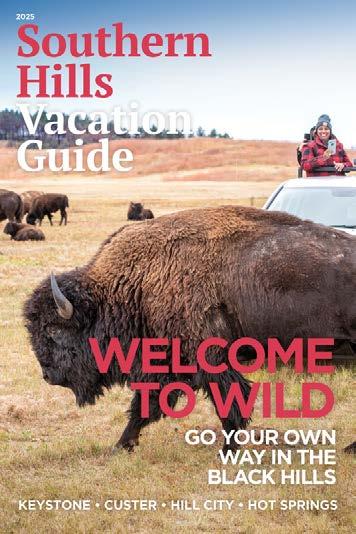


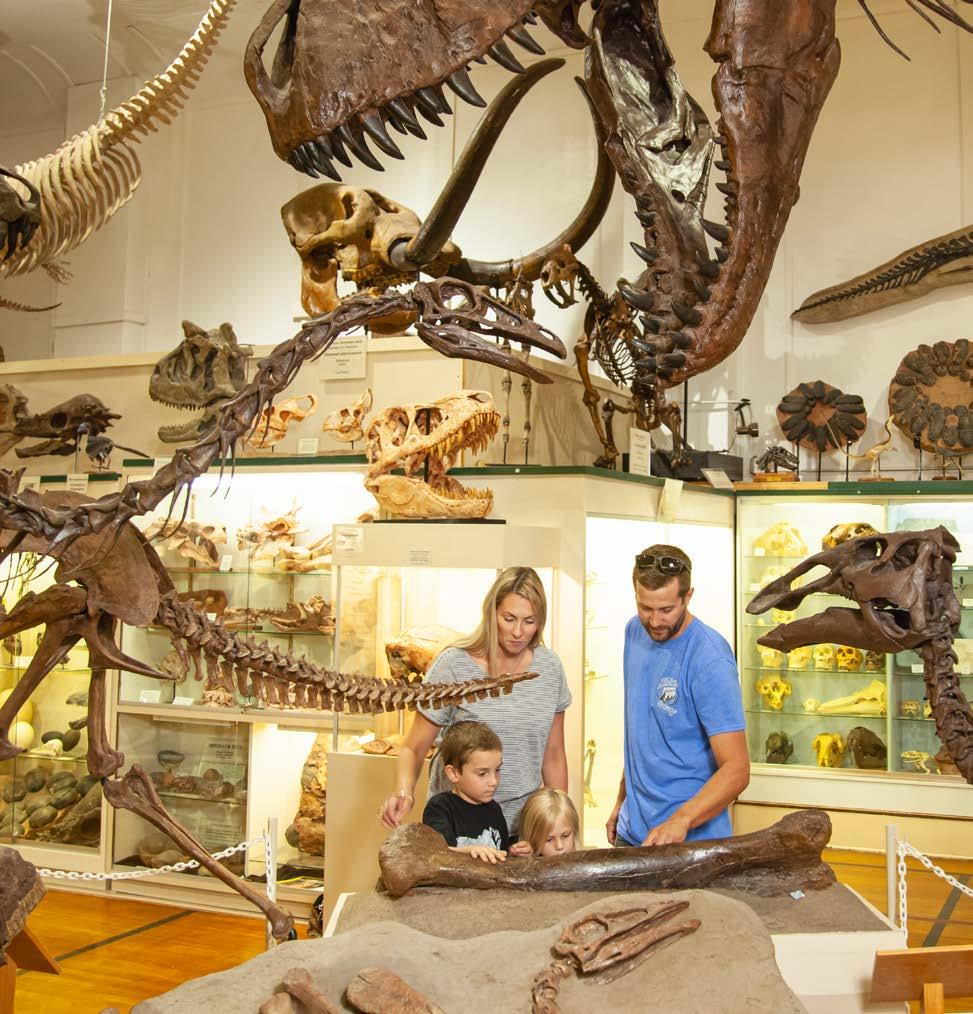
The Black Hills region is a haven for paleontology and geology enthusiasts, offering a variety of museums dedicated to the prehistoric past. These museums feature impressive collections of fossils, many of which have been unearthed in local archaeological sites. Dinosaur fossils, including those of Tyrannosaurus rex, Triceratops (South Dakota’s official state fossil), and the duck-billed Edmontosaurus, are on display, showcasing the rich prehistoric life that once roamed the area. Additionally, fossils of mammoths and other ancient mammals provide valuable insights into the diverse ecosystems of the past. Some of the museums in the Black Hills are active research sites, allowing visitors a rare chance to observe paleontologists at work.

The South Dakota Air & Space Museum is a must-stop for aircraft enthusiasts.
Length of the largest dinosaur found in South Dakota, a Barosaurus
180 Million
Reign of the dinosaurs, encompassing the Jurassic and Cretaceous periods of the Mesozoic Era
PALEO-LOVERS, HERE’S YOUR BLACK HILLS BUCKET LIST:
Museum @ Black Hills Institute
Museum of Geology at SD Mines
Dinosaur Museum
The Journey Museum
The Mammoth Site
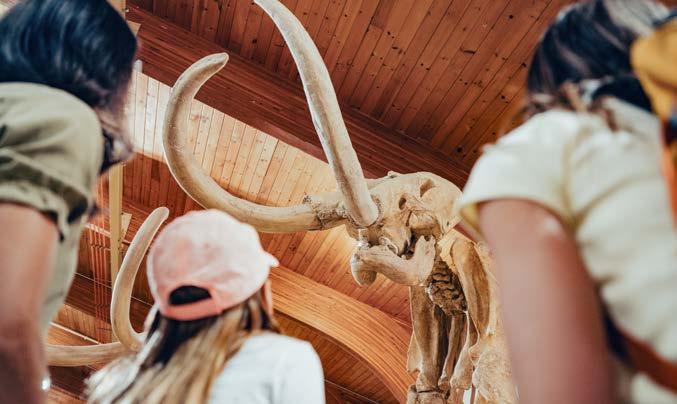
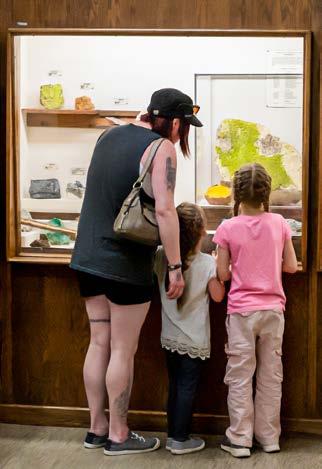
The region’s geological history is equally fascinating, with exhibits focusing on the formation of the Black Hills and the surrounding landscape, including detailed displays on rock formations, mineral deposits, and the processes that shaped the land over millions of years.
The Black Hills also offer a wide range of other historical exhibits. Local museums provide fascinating insights into the area’s Indigenous and pioneering past, with displays on early settlers, Indigenous artifacts, homesteading, and more. And don’t miss out on learning about the Black Hills’ rich aerospace heritage.
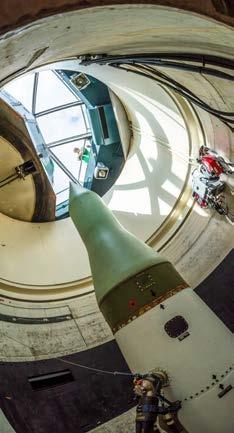

In eastern South Dakota, Sioux Falls, south of I-90, stands as the largest city in the state. Stop at Falls Park to break up the drive.
AS YOU APPROACH THE MISSOURI RIVER , stop at the Chamberlain Rest Area—the location of Dignity, a 50-foot sculpture of a Native American woman wearing a traditional star quilt. Look to the north to view the Chamberlain Bridge, a historic connector for the towns
The highest elevation along I-90 is in South Dakota, at 1,729 feet
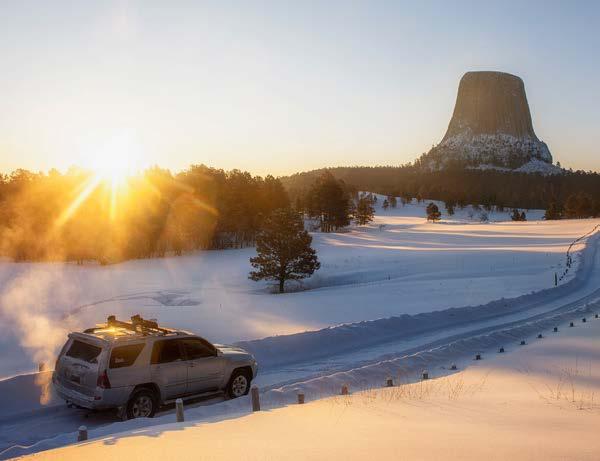
of Chamberlain and Oacoma. Near Kadoka, to the south as you follow I-90 through western South Dakota, the Badlands appear. Exit 131 is the east entrance into Badlands National Park and the Visitor Center of Minuteman Missile Site.
WALL DRUG is where you will find everything from souvenir shops to a giant animated T. Rex and plenty of space for the kids to unwind after a long day on the road.
RAPID CITY, the second largest city in South Dakota, has something for everyone. Fine dining, unparalleled shopping, festivals and special events, recreation, and entertainment come together in
867 feet above its base, Devils Tower in Wyoming boasts over 50 routes for climbing.
50 feet into the sky stands Dignity, a sculpture of a Native American woman wearing a traditional star quilt.
the city in unforgettable ways. From Rapid City through the foothills of the Black Hills— to Sturgis, Whitewood, and Spearfish, and into the Bear Lodge Mountains as you near Sundance, Wyoming— drivers cross the northern part of the “Red Racetrack.” Believed by the Lakota Sioux to encircle the entire Black Hills, the legendary track was the site of the “Great Race” between humans and buffalo. The story is associated with the origins of several traditional practices. While 90 percent of the Black Hills lies within South Dakota, the Black Hills National Forest does continue 10 to 40 miles into Wyoming.
WEST OF SUNDANCE, as you near Moorcroft, look to the north for occasional glimpses of Devils Tower National Monument. At Ranchester, take scenic US Highway 14 over the Bighorn Range and through Shell Canyon to Cody. This part of Wyoming is where Buffalo Bill Cody, along with diverse cultures associated with Western life, are celebrated. Cody is also known as the eastern gateway to our nation’s first established National Park in 1872— Yellowstone.
The rugged 244,000 acres of the Badlands draws visitors from around the world with its unique landscape.
MILEPOSTS ALONG
I-90:
• 399 to 396—Sioux Falls: lodging, dining, shopping, museums, and attractions
• 335 to SD 38E to SD 25N—DeSmet: Laura Ingalls Wilder’s Homestead
• 332 to 330—Mitchell: The world’s only Corn Palace, dining, lodging
• 265 to 263— Chamberlain: between exits are the 50-foot Dignity sculpture and the Lewis & Clark Visitor Center. Relive Lewis and Clark’s journey with interpretive panels that explain the Corps’ traveling adventures through present day South Dakota. This is a great place to get out, stretch, and enjoy views of the Missouri.
• 260—Oacoma: Al’s Oasis and Cedar Shores Resort
• 212 to US 83N, SD 53—Pierre: South Dakota’s state capital
• 191 to 192—Murdo: Pioneer Auto Show features more than 250 antique classic cars
• 131—Cactus Flats: Badlands National Park
northeast entrance, Minuteman Missile
National Historic Site Visitor Center
• 110 to 109—Wall: Wall Drug Store, National Grasslands Visitor Center
• 67B— Box Elder: South Dakota Air and Space Museum
• 67A—Box Elder: Ellsworth Air Force
Base Main Gate
• 61 to 52—Rapid City: lodging, dining, shopping, museums, and attractions
• 30—Sturgis: Bear
Butte State Park, Old Ft. Meade
• 7 to US 85S— Deadwood, Lead: gaming and museums
• 14 to US 14A— Spearfish: The town of Spearfish, Spearfish Canyon Scenic Highway
• 10 to US 85N— Belle Fourche: Center of the Nation, Tri-State Museum
• 1—State Line: South Dakota Visitor Center and rest stop
MILEPOST ALONG I-90:
• 205—Beulah: Vore Buffalo Jump
• 199 to WYO 111— Aladdin: Devils Tower
• 185 to 187 (Sundance) to US 14— Devils Tower
• 153—Moorcroft
• 124 to128—Gillette: Lodging, dining, shopping, historic sites
• 56 to 56B (Buffalo) to US 16 to Cody— Yellowstone National Park
• 20 to 25—Sheridan: Lodging, dining, shopping, historic sites
• 9 (Ranchester) to US 14 to Cody— Yellowstone National Park
